- Home
- Middle East News
- About USA Weekly News
- World News
- INLNews News Headlines
- Benjamin Netanyahu Israel
- US Politics
- UK Ireland News
- Saleh al-Arour killed
- Israel Genocide ICJ Case
- Israel Mossad Hamas Cash
- INLTVNews VideosP1
- Netanyahu RothschildCrime
- Pippin Drysdale Artist
- Wayne Hastings CarewReid
- Lloyd Carew-Reid Music
- Adam Carew-Reid Business
- Hidden Tribes In the USA
- Trump Shooting Analysis
- Irish Crime Exposed
Pippin Louise Drysdale (Carew-Reid) Famous Ceramic Artist
Pippin Louise Drysdale (Carew-Reid) Most World Famous Australian Ceramic Artist
https://inltv.co.uk/index.php/pippin-louise-drysdale-nee-carew-reid-world-famous-ceramic-artist
Pippin Louise Drysdale (Nee Carew-Reid) World Famous Ceramic Artist
is the sister of multi billinaire PertWestern Australian buasibessman Wayne Hastinggs Carew-Reid
https://usaweekly.com.au/wayne-hastings-carewreid
PippinLouiseDrysdale(Nee Carew-Reid)WorldFamousCeramicArtist
Inside The Fremantle Studio Of Ceramics Legend, Pippin Drysdale
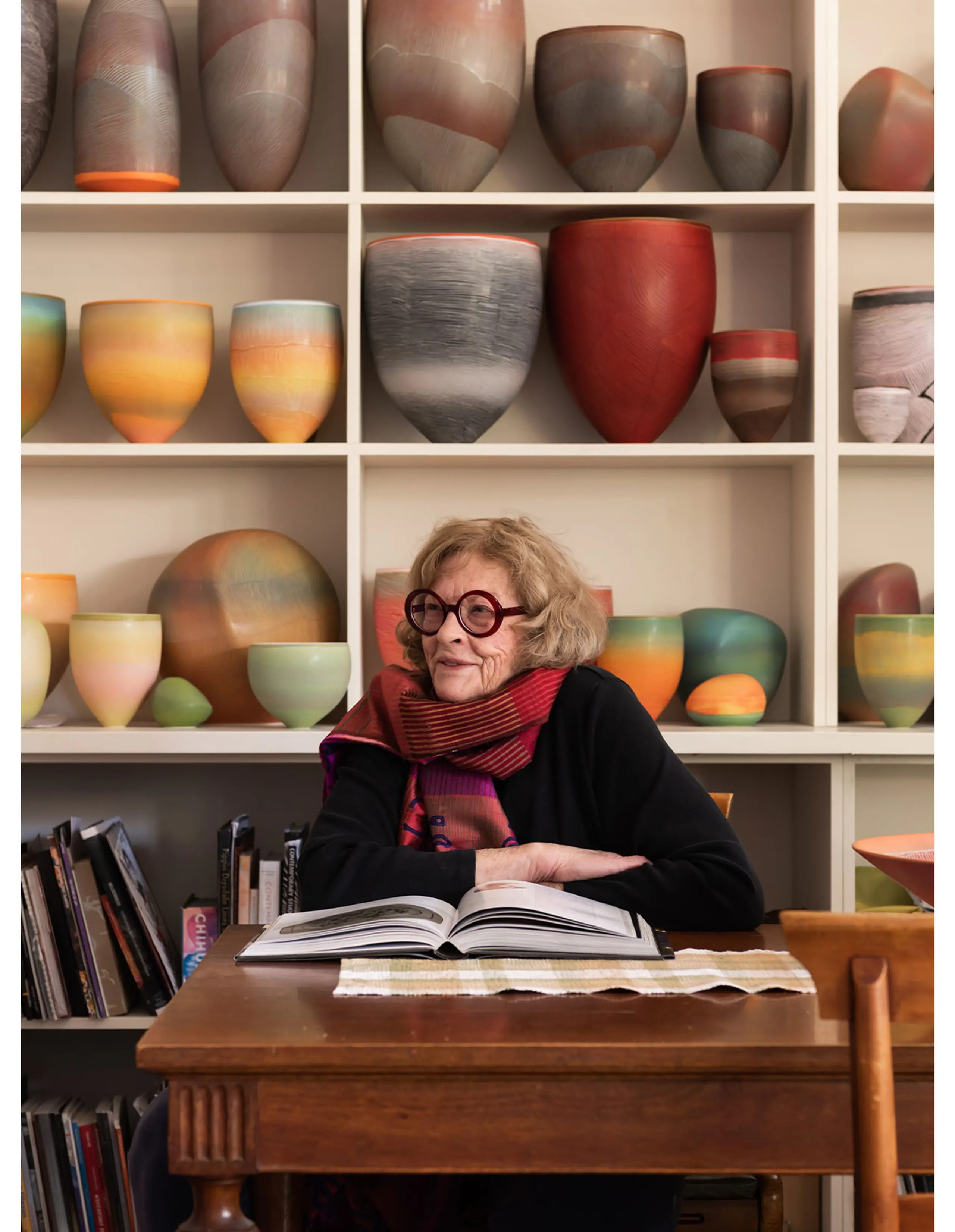
Pippin Louise Drysdale (Nee Carew-Reid)
Sun Arts Pippin Louise Drysdale (Nee Carew-Reid)July 30th 2009 Australian Ceramic Artist Pippin DrysdaleTalks On ABC Sunday Arts Programme About Her WorkApr 15, 2010

Pippen Louise Drysdale's (Nee Carew-Reid)
“I’m probably the luckiest ceramic artist in the world. I’ve worked hard. But to have had the passion [to do] something I really love.” – Pippin Drysdale
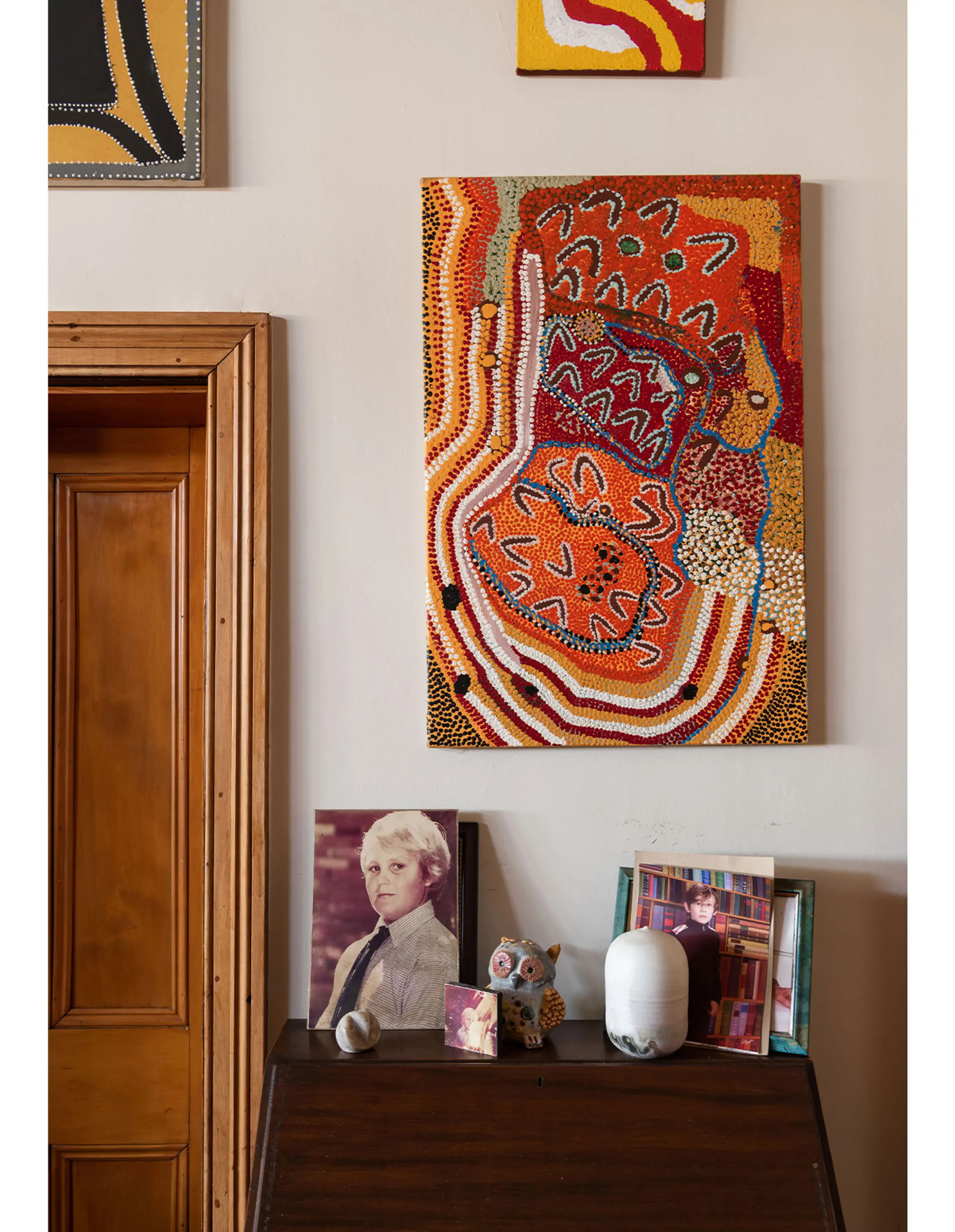
Pippin Louise Drysdale (Nee Carew-Reid)
Pippen Drysdale (Nee Carew-Reid) Talking About The Process Of Her Ceramic Art Work Part 3.
".... Please take the time to look at the other amazing artists displayed further down this webpage... such as .."
Studio Elke Relaunches With New Hand-Made Ceramic
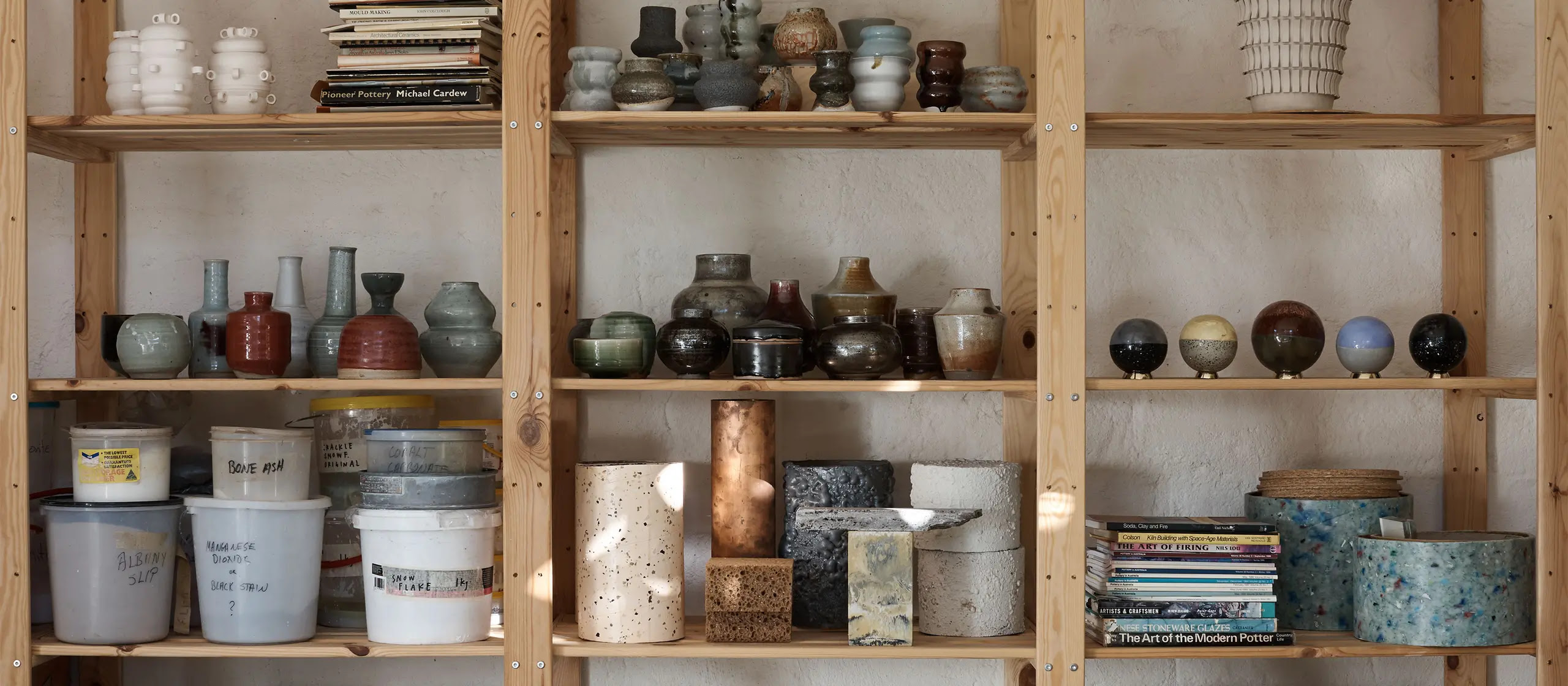
Why The Internet Is In Love With Libby Haines’ Beautiful Still-Life Paintings

How Powerhouse Designer Lucy Simpson Is Making Waves
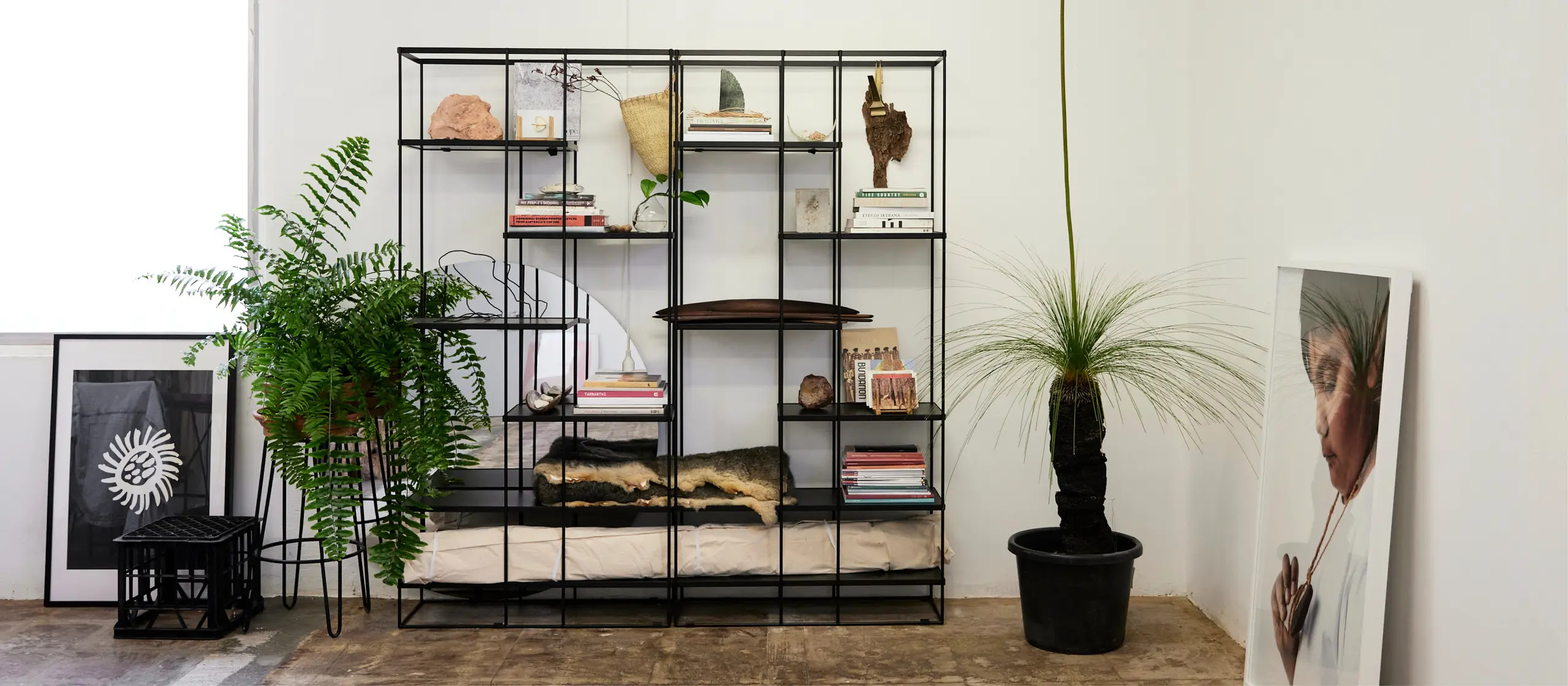
Inside Melbourne Artist Hilary Green's Playful + Surreal Practice
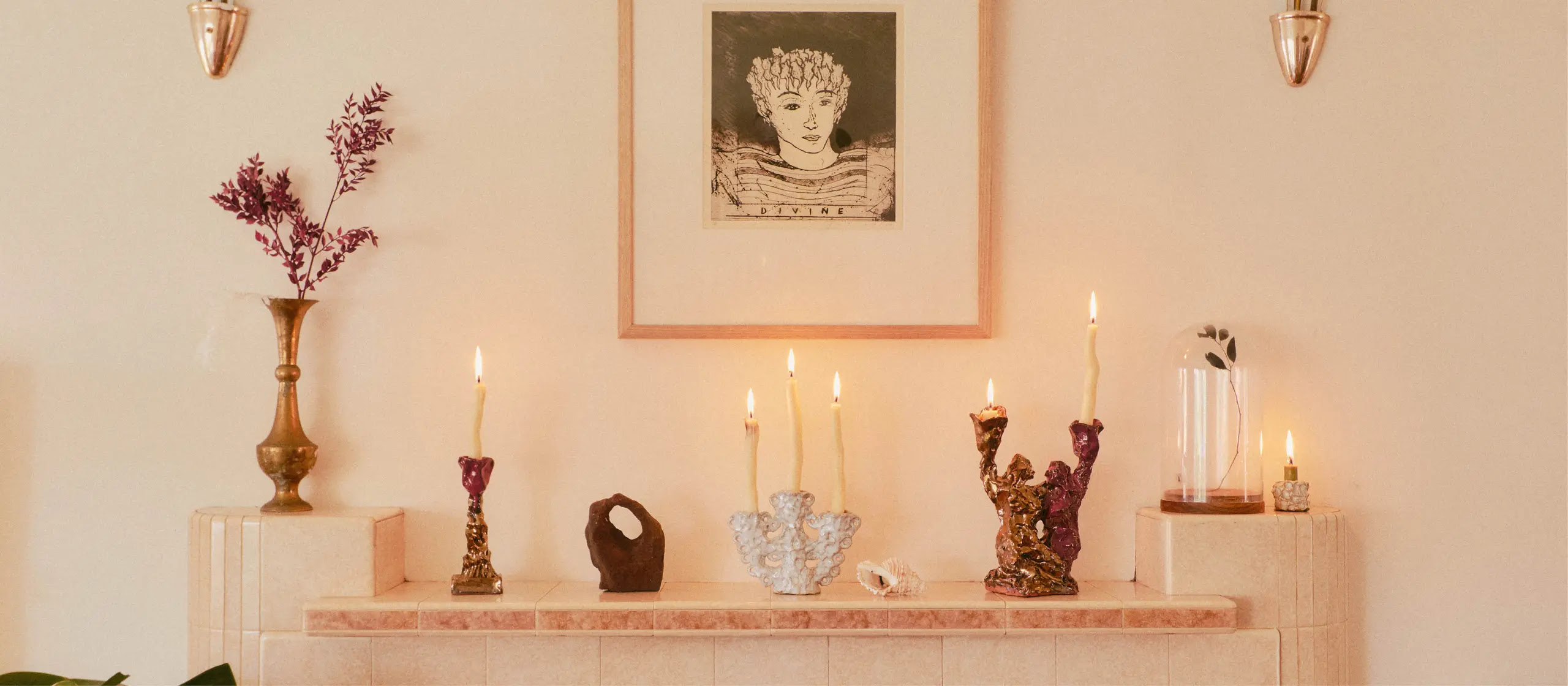
How Ceramic Artist Lucy Tolan Became One Of Melbourne’s Favourite Creatives
Lucy Tolan’s beautifully handcrafted ceramics are instantly recognisable – and they’re constantly appearing on the carefully curated coffee tables, consoles and shelves in many of our home tours!

Miranda Hine’s Alluring Paintings Of English House Museums
The joy of creating underpins Miranda Hine’s oil paintings depicting quiet interior and still life scenes.

The Environmentally Regenerative Ceramics Studio Of Casa Adams
Casa Adams is a ceramics practice founded by Araceli Robledo Adams that aims to spark curiosity and protect nature — an ethos that extends to the studio’s physical workspace.

Pippen Louise Drysdale's (Nee Carew-Reid) recalls how she used to invite groups of wealthy WA collectors around to her studio “to get the first bite of the cherry” before a body of work was sent to a show. “I’d have all these pots on shelves and I’d give them each one of these torch-lights, it was hilarious! We’d go round and look at every piece and by the end of the evening I would have sold $20,000 or $30,000 worth of pots.”
“I’m probably the luckiest ceramic artist in the world. I’ve worked hard. But to have had the passion [to do] something I really love, and to have so much gratification around the world for my work is amazing. My Dad would have been proud of me. It’s taken a long time, a good 40 years. But you’ve got to do your time, and I’ve been very fortunate to have [had] all the time in the world.”
Gallerists such as Marianne Heller and Anna Grigson, of Quadrivium and Sabbia have also been instrumental, along with her dealers in London, Joanna Bird, and Adrian Sassoon in particular, who takes her work to the world’s major art fairs: Maastricht Art Fair, Holland, and Masterpiece, PAD, and COLLECT in London and The Salon: Art + Design in New York. These dealers have contacts with collectors who buy her work, although Drysdale has always been well-connected in her own right, and a canny marketer and self-promoter.
Some unpublished facts about Pippin Drysdale (Nee Carew-Reid) exclusive to the INLTV News Pippin was making cups and plates out of clay for quite sometime and selling them every Sunday at the local Fremantle Markets for around $20 to $50 each...Then one day Pippin decided to use her market manageress skills and well connected contacts with wives of multi millionaires Pippin was friendly with ..... Pippin having gone to Methodist Ladies College with the sons and daughters of the who's who of Perth .... with many of her old school mates becoming some of the wealthiest and well connected people in the business, legal, radio, television, newspaper, banking, arts and financial groups in Perth, Western Australia..One of Pippin's close female friends was Janet Homes a Court, who was the wife of multi millionaire businessman, the late Robert Homes a Court...Janet would often drop into Pippin's cottage at 22 Tuckfield Street, Fremantle for morning tea,and to purpose some of Pippin's herbs from Pippin's herb garden ...One particular morning while Janet and Pippin were enjoying a cup of herbal tea and a home made scone, Janet noticed that Pippen had a massive blue coloured plate that Pippin had made from clay and fired in a unusual various selection of blue colours .... Janet then asked"Pippy.... did you make that lovely very large blue coloured plate on your kitchen shelf...Pippin replied..." Yes Janet this is one of my personal Pippy creations..."Janet then said.." oh Pippy, that lovely blue plate would look excellent on my new glass cabinet in my home entry porch, how much would you sell your plate to me to me for?"Pippen was caught out not knowing exactly what to say .. and had to act very naturally and relaxed, while she decided of a price she would ask Janet for her plate... while keeping in mind that Janet and her husband Robert Homes a Court where very wealthy multi millionaires, and thus money was no object to them.. $50,000 to $100,000 would have been petty cash for them... so Pippy just picked s figure out of the air of $25,000...Janet replied ..... Not a problem Pippy $20,000 is fine.." Then Janet casually wrote out a personal cheque to Pippen for $25,000.Janet Homes a Court, left Pippin's cottage at 22 Tuckfield Street, Fremantle, and went home. and proudly placed her new Pippin Drysdale Creation purchase in her new glass cabinet, which was in her entry porch of her multi million dollar Mosman Park Home.Then the next day Janet had a few of her girls friends over for morning tea, who were wives of other Perth multi millionaires.... as they all walked into Janet's porch.... they all said ...."Janet were did you purchase that amazing large blue plate form and how much did it cost..?"Janet replied ..... " oh I purchased that beautiful unique blue plate from my good friend from Pippy Drysdale... for quite a cheap price of $25,0000 .. there is no doubt in my mind this plate will e worth over $100,000 in time to come...."All of Janet's multi millionaire friends all said that must have one as well, and they all ordered a plate each from Pippin Drysdale for $25,000 each .. That is the absolutely publicly untold true how the value of Pippin Drysdale's pottery pieces overnight. when from a market value of around $20 to $50 to $1,000 to $25,000 .... Watch this space for more publicly unknown true stores about the world famous Ceramic Artist Pippin Louise Drysdale (Nee Carew-Reid) https://en.wikipedia.org/wiki/Janet_Holmes_%C3%A0_Court Janet Holmes à Court, AC, HonFAHA, HonFAIB (born Janet Lee Ranford on 29 November 1943 in Perth, Western Australia) is an Australian businesswoman and one of Australia's wealthiest women. She is the Chairperson of one of Australia's largest private companies, Heytesbury Pty Ltd, having turned around its fortunes after the death of her husband Robert Holmes à Court in 1990. She retained full ownership of the Heytesbury Group of companies until 2008 when her son, Paul Holmes à Court, assumed ownership, while she remained chairman. Pippin says she finds listing to Bob Dylan Musichelps her artistic creativity and artistic inspirtionBob Dylan 1998 Voices In The Night Best Of 1998One of Pippins Favourite Australan Bob Dylan Concerts Pippin Will Never ForgetPippin says "God Bless Tom Petty ... it is so sad Tom is still not around to play and singe to us anymore..! BOB Dylan Hard To Handle Live In Australia 1986 With Tom Petty And The Heartbreakers Sun Arts Pippin Drysdale (Nee Carew-Reid)July 30th 2009 Australian Ceramic Artist Pippin DrysdaleTalks On ABC Sunday Arts Programme About Her WorkApr 15, 2010

Pippen Louise Drysdale's (Nee Carew-Reid) clay turner Warwick Palmateer
Pippin Drysdale and Warwick Palmateer are doing a
major collaborative exhibition at John Curtain Gallery in September 2018.
Pippin Louise Drysdale (Nee Carew-Reid) On SundayArts Apr 15th 2010 Leading Australian Ceramicist Pippin DrysdaleTalks About Her Work On Sunday ArtsLeading Australian ceramicist Pippin Drysdale talks about her work on Sunday Arts Internationally renowned, Pippin Drysdale is a major figure in Australian art. Drysdales mastery of the medium has seen her repeatedly break boundaries with new glazes, new shapes and new techniques. Never content to lock into a formula she continues to push her practice. Emphatically inspired by her surroundings, Drysdales creative process is one of an intuitive response to the landscape. Driven by a need to capture an "essence" in simplicity of form, her ceramic pieces are characterized by their skillful pattern work and colouring, reminiscent of markings found in nature. Born in Melbourne, Drysdale studied ceramics in Perth and spent much of her childhood on country properties in Western Australia; not surprisingly it is here that her love of the bush was awakened. This affinity with the landscape continues to be evident in her work today. Involved in an active program of lectures, workshops and residencies across Australia and around the world. She has taught in places as varied as the Swansea Art College (Wales), the Deruta Grazia Maioliche Factory (Italy), Princeton University (USA), and Tomsk University (Siberia). Represented in many Australian and international collections including the National Gallery of Australia; Art Gallery of Western Australia; Holmes á Court Collection (Perth, WA), Tomsk State Gallery and Museum (Siberia), Auckland Museum and Art Gallery (New Zealand), Museum of Modern Art (Gifu Japan), Cheongju Museum and Art Gallery (Korea), Twenty-First Century Museum (Kanazawa Japan) and the Museo del Ceramica, Faenza, Italy. To view more of Pippin's work please visit http://www.michaelreid.com.au/artists...
EXHIBITIONS
October 9, 2021 - October 31, 2021
PIPPIN DRYSDALE – THE PATTERNING OF LIGHT: BREAKAWAY SERIES II 2021
Artist: Pippin DrysdaleLocation: Subiaco9 - 31 OCTOBER, SUBIACO.Official Opening 6-8pm Thursday 14 October. Exhibition opened by Mr Chris Malcolm, Director, John Curtin Gallery. Internationally renowned Australian ceramic artist Pippin Drysdale presents The Patterning of Light I Breakaway Series II 2021, an exhibition celebrating the minutiae of the Australian environment. For 45 years Pippin Drysdale’s well-ordered studio in Fremantle, Western Australia, has witnessed the creation of exquisite landscapes ‘in the round’, made on her porcelain vessels, marbles or platters, each of which is the result of her endless and focused experimentation with colour, line and shape, applied in her unique fashion to the ceramic sculptures she creates. Over the years, these sculptures have reflected the vast Australian landscape, the remote and grandiose geology of the famous Kimberley or Pilbara regions, as well as the stories of Australia’s first peoples. Now in 2021, the focus is changing. “As I have continued to explore my Breakaway Series,” says Drysdale,“I have become increasingly fascinated with the properties of light within the landscape and my focus has moved from the “vastness” of the images to the “smallness” of things – the way light bounces and bends with the breeze on the water; filtered light through gently moving vegetation; the iridescence of dragonfly wings; the fluttering of fish; the glisten of frogs; the dew on the leaves and rocks. Correspondingly I have been consciously seeking an increased sheen to my vessels, making smaller vessels as little surprises and my palette has shifted from the broader colours of the land, the water and the sky to the subtleties of the small and wonderful.” Indesign Luminary: Pip Drysdale | IndesignLivehttps://www.indesignlive.com/people/indesign-luminary-pip-drysdale Published by Jan Howlin June 6, 2018
Australia has produced some fine ceramicists, but none has achieved the international prominence of Pip Drysdale, which makes her an Indesign Luminary alumni.
Even with an international resurgence of interest in ceramics, Pippin Drysdale is something of a phenomenon – an Australian ceramicist who has built a significant profile in the international arena.
Early Life of Pippin Louise Drysdale (Nee Carew-Reid)
Born in 1943, Pippin Carew-Reid grew up, the eldest of four siblings, in highly privileged circumstances in Perth. Her father, a successful businessman and entrepreneur, “was always a big picture man and, of course, he gave me big picture thinking”. She already had her own big personality to go with it. A gung-ho character with an explosive laugh, a boots-and-all attitude and a roller-coaster history, Pippin was always interested in art and colour. She married Christopher Drysdale, second cousin of painter, Russell Drysdale, in 1967, and following the birth of son Jason, the couple separated in 1972.
After two business ventures and another relationship, she found herself in her early thirties with a potter’s wheel and a kiln and decided she would learn to make pots. “I just loved the feeling of making things with clay. I loved the challenge.”
After two business ventures and another relationship, she found herself in her early thirties with a potter’s wheel and a kiln and decided she would learn to make pots. “I just loved the feeling of making things with clay. I loved the challenge.”
She studied ceramics at Perth Technical College, although a residency at Anderson Ranch Arts Centre, Colorado, was particularly formative. “There were all these amazing potters,” including Paul Soldner, Toshiko Takaezu (who became her friend and mentor) and author, educator and ceramic artist, Daniel Rhodes, who offered her great encouragement.

On his advice she returned to Australia and, with the help of arts academic, author and family friend Ted Snell, she enrolled at Curtin University to do a BA in ceramics.
Drysdale had been throwing bowls, but at this time she made slab plates, using the surfaces as canvases for expressionistic drawing. She used coloured slips (liquid clays), glazes, and resists such as masking tape and latex to create imagery by layering often-spontaneous mark-making, (Window series, 1986.)
.
“I just wanted to work with colour, colour, colour.” – Pip Drysdale
.
She cites Willem de Kooning as an influence, but also says “I just wanted to work with colour, colour, colour.” Over the next few years, she produced series after series, motivated by the landscapes around her and environmental concerns – for example, the Treescape (1989) and Logging on Parchment series (1990). By this time her work was being selected for national exhibitions, and she began teaching and giving workshops around Australia.
International Appeal
In the early 1990s, Drysdale abandoned the slab plates, but continued her spontaneous style of decoration on her wheel-thrown pots. “I love pure form. I’ve never wanted to be complicated with form because I love to be extravagant with the surface.” She did residencies in Wales, Italy, Russia and the USA.
In Italy, she learned the majolica technique of decorating on (unfired) glaze, and the use of lustres, a process in which a thin film of light-diffusing metal is fused to the ceramic surface after glazing (Totem and Carnivale series). An Australia Council grant, one of many she received over the years, allowed Drysdale to pursue lustres here, and from her Russian experience she produced the aptly named Over The Top series, exuberant works in which gold and platinum lustres were put to opulent effect.

She also travelled in Western Australia, producing the Landscape Lustre (1994), Pinnacles (1995) and the rich and evocative Eastern Goldfields series, which was praised by New Zealand art critic, Howard Williams, for “distilling an expression descriptive of Australia without resort to the obvious symbols of flora or fauna”. Around this time she also began collaborating with master potter, Warwick Palmateer, who threw the vessels for her, allowing her to focus on decoration.
Drysdale’s freewheeling spontaneity and masterly use of glazes and lustres reached its peak after a trip to Pakistan. “Those pots from the Pakistan series were phenomenal because I literally poured glazes all over them, then poured paraffin wax all over and then gashed back and filled, gashed back and filled, there were loads of layers. I just worked with my own intuitive madness at the time.” It is easy to see these works as a direct expression of her larger-than-life persona.

Lustre series: White Feather Mine collection. Sold to New York collector via Adrian Sasson.
After exhibiting the Pakistan series at Quadrivium in Sydney in 2000, she included some pieces in a group show, Australian Contemporary Ceramics, which gallery-owner, Marianne Heller, had organised in Heidelberg, Germany. Heller then offered Drysdale a solo show there, a major opportunity, and one that led Drysdale to re-think her practice.
New Finishes
Because of the toxicity and firing hazards inherent in their use, Drysdale abandoned the waxes and lustres, and found and perfected a (safer) new resist medium (Liquitex) that lent itself to much more controlled and sensitive linework. She also took a strategic view of the German market.
“They’re intense, they’re restrained, they’re minimal, they’re subtle – they’re everything I’m not!” A feeling of Australianness was another “very intentional” objective for the new work, and again her travels provided her direction.
In 1998, on a Creative Development Fellowship from ArtsWA, Drysdale had flown with a small group of art collectors to visit remote Aboriginal communities in northern Australia. “That particular trip is still what inspires me today,” she says. “When you’re flying low out in the Great Sandy Desert or the Tanami Desert, you’ve got this infinity of shadow and line and ripples, shadow and light.

Horizon Dawn, sold to Tim Roberts.
Subconsciously, I was very influenced by indigenous painting, and when I did that journey it reinforced that aerial sense,” she says, citing painter, Fred Williams, as an influence for the same reason. After much experimentation back in her Fremantle studio, Drysdale arrived at the fusion of intense colour, fine linework and technical precision that became the first Tanami series.
The exhibition, Red Desert, was to be shown at Galerie Marianne Heller, in Heidelberg in 2003. But, due to a fire, it was transferred to the prestigious MAK Museum in Frankfurt, where it was a spectacular success. As Heller wrote in the catalogue: ‘”…the serenity and calmness radiated by Pippin’s vessels almost seem like a force from another planet”.
Certainly Drysdale’s career took a stellar turn as a result, with acquisitions by major international museums, invitations to exhibit, accolades and sales. It is a trajectory that has continued for over ten years, as Drysdale has continued to draw on the landscapes and flora of northern Australia, from the deserts to the Kimberley.
Later Times
While the restraint in Drysdale’s work since Red Desert represents a radical departure from her earlier work, her practice (despite its earlier vigour and spontaneity) has always maintained a rigorous approach to the materials and processes of her craft.
“Everything is meticulous,” she says, and in a state of continual refinement. Far from being a sole operator, Drysdale’s production is something of a small industry.

Tanami Traces, 2007, collected by Tim Lyons.
She is assisted in the studio by a small, dedicated part-time team who assist with glaze mixing, firing, colour testing, sanding of bisque-ware, website and computer work, and packing and despatch of the work to shows. Drysdale values the input of all concerned. She is also grateful to the many people who have contributed to her success.
Ted Snell has been a significant supporter over many years, arranging a major retrospective for her, Lines of Site at John Curtin Gallery, Perth, in 2007. “Ted Snell has probably been one of the best catalysts in my life,” says Drysdale.

Lizard Warming, large pieces sold, others available through Adrian Sasson.
Gallerists such as Marianne Heller and Anna Grigson, of Quadrivium and Sabbia have also been instrumental, along with her dealers in London, Joanna Bird, and Adrian Sassoon in particular, who takes her work to the world’s major art fairs: Maastricht Art Fair, Holland, and Masterpiece, PAD, and COLLECT in London and The Salon: Art + Design in New York. These dealers have contacts with collectors who buy her work, although Drysdale has always been well-connected in her own right, and a canny marketer and self-promoter.
Australia has produced some fine ceramicists, but none has achieved the international prominence of Pip Drysdale, which makes her an Indesign Luminary alumni.
Even with an international resurgence of interest in ceramics, Pippin Drysdale is something of a phenomenon – an Australian ceramicist who has built a significant profile in the international arena.
Recognised as a Master of Australian Craft in 2007, Drysdale’s distinctive porcelain vessels, with their arresting colour, subtlety and originality, are held in many major museums and private collections internationally and nationally. Her work is regularly shown at the world’s major art fairs and keenly collected by wealthy patrons, making her the highest earning ceramicist Australia has ever produced.

Gibb River Burn
Approaching Drysdale’s ceramics, however, evokes awe and trepidation. At her May 2014 solo exhibition at Sydney’s Sabbia Gallery, a number of tall pots stood alone on their plinths, with other works arranged in groups, from two or three up to large extended families of forms. Most were vessels, some were closed forms, but all stood on small, fate-tempting bases. You imagine a loud noise would topple them, or a sudden breath of wind would have them in pieces.
But stand they do, in what has been called a delicate balancing act – they are much heavier in the base than their fine rims would indicate – radiating their often dazzling, highly saturated colours and creating a simultaneous sense of composure and tension.

As Perth-based art critic, David Bromfield puts it: “To contemplate them is an extraordinarily moving visual experience, a moment in which one recovers a sense of universal harmony, absolutely free of clichés.”
Story continues below advertisement
While the interiors are usually filled with a single rich gradated hue, across the outside surfaces patterns of fine lines meander, falter and collide, marking out their terrain. Many of the vessels are glazed in the brilliant red, orange and rust tones of the deserts of North-Western Australia, which provided their initial inspiration.
For over ten years now Drysdale has made works in response to these landscapes – Tanami Traces, then Tanami Mapping, now in its third series – each new body of work reinforcing its connection to this unmistakably Australian imagery. Drysdale’s arrival at the restrained clarity of these works has marked a definitive stage in her career, although she has almost always used the landscapes she has experienced, at home or abroad, as creative springboards.
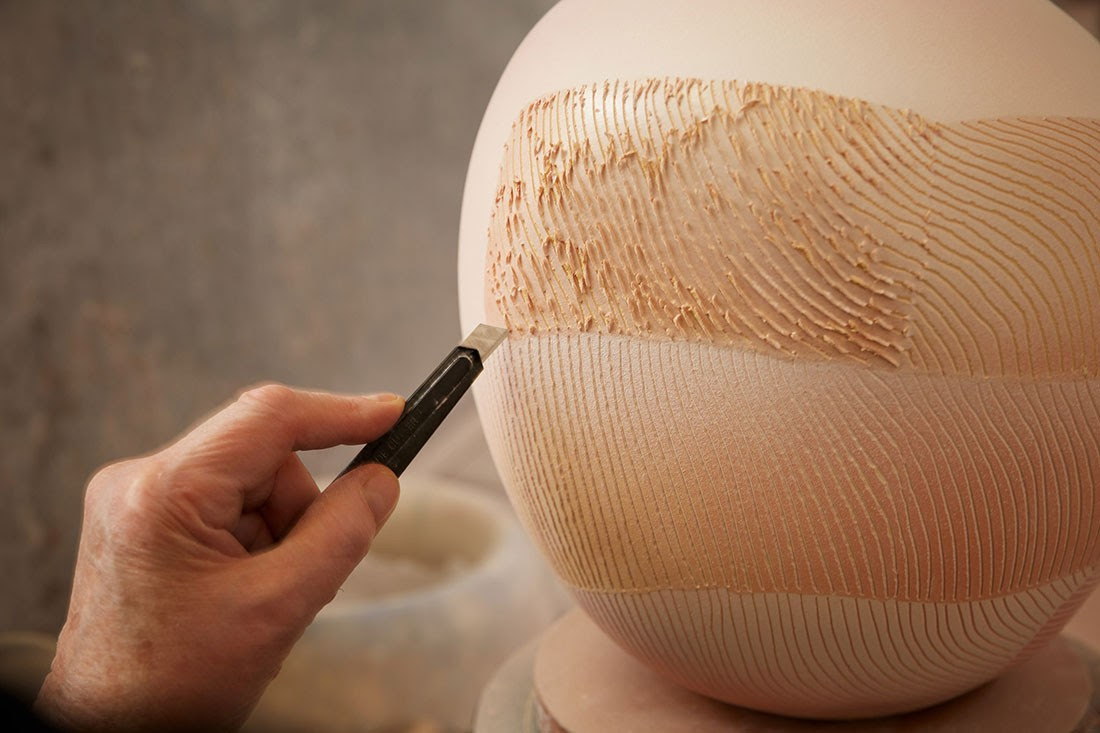
Photo by Rob Frith – Acorn Photo.
Inside The Fremantle Studio Of Ceramics Legend, Pippin Drysdale
https://thedesignfiles.net/2021/10/studiovisit-pippin-drysdale


Inside The Fremantle Studio Of Legendary Ceramicist, Pippin Drysdale

Pippin Drysdale has been working as a ceramic artist for over 40 years, all of which she has spent fascinated with colour. Her bold, vivid porcelain vessels vary from plump, misshapen orbs to thin, wide-brimmed vases, emblazoned with a spectrum of hues found in the Australian landscape.
The onset of the pandemic marks the first time Pippin has been in one place for more than three months, allowing her time and space to shift her focus from the vast, sweeping desert plains of remote country, to the smallness and minutiae of the natural world.
We visited Pippin’s home studio in Fremantle to learn more about her unique practice. This is where the magic happens!
Written by Sasha Gattermayr 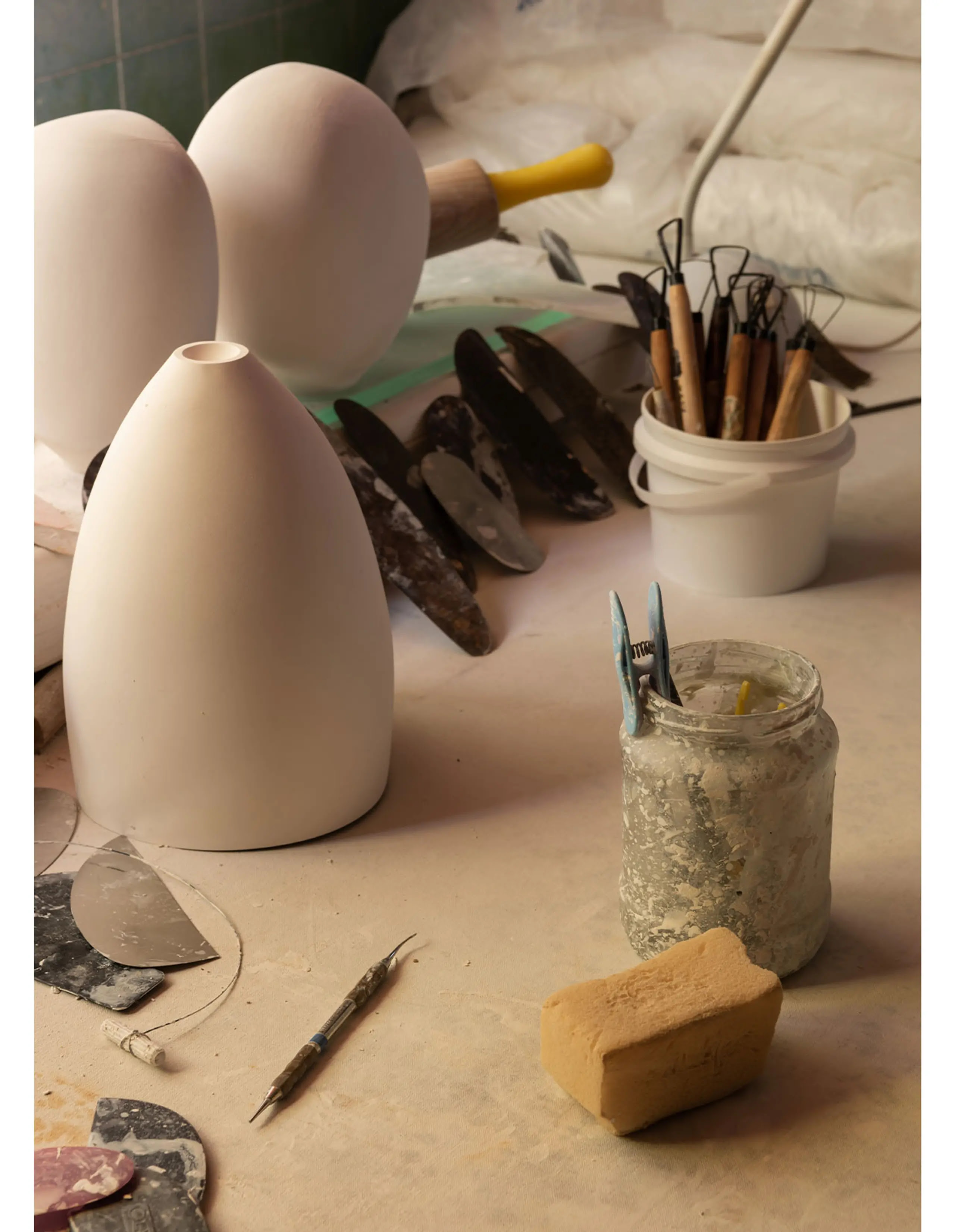
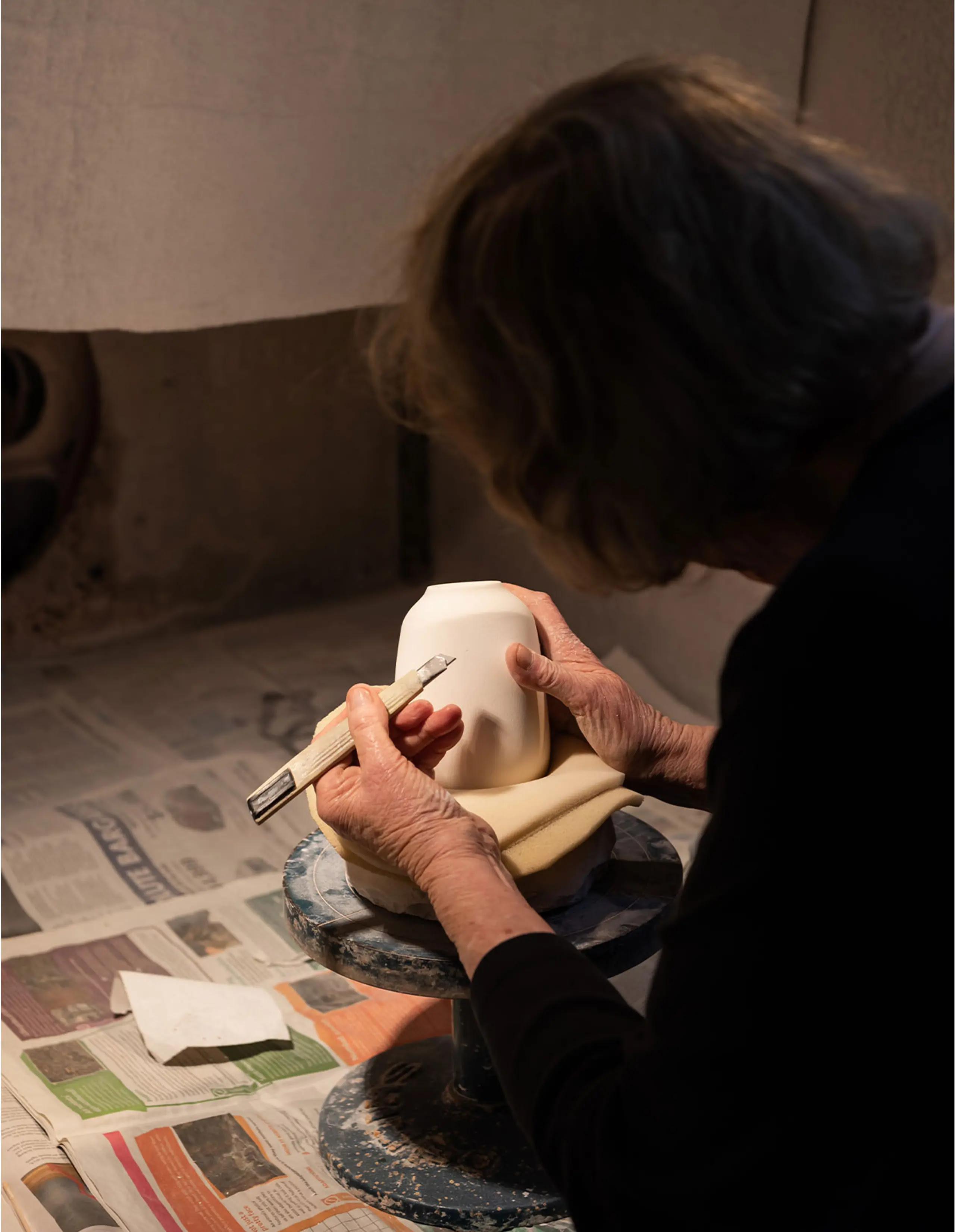
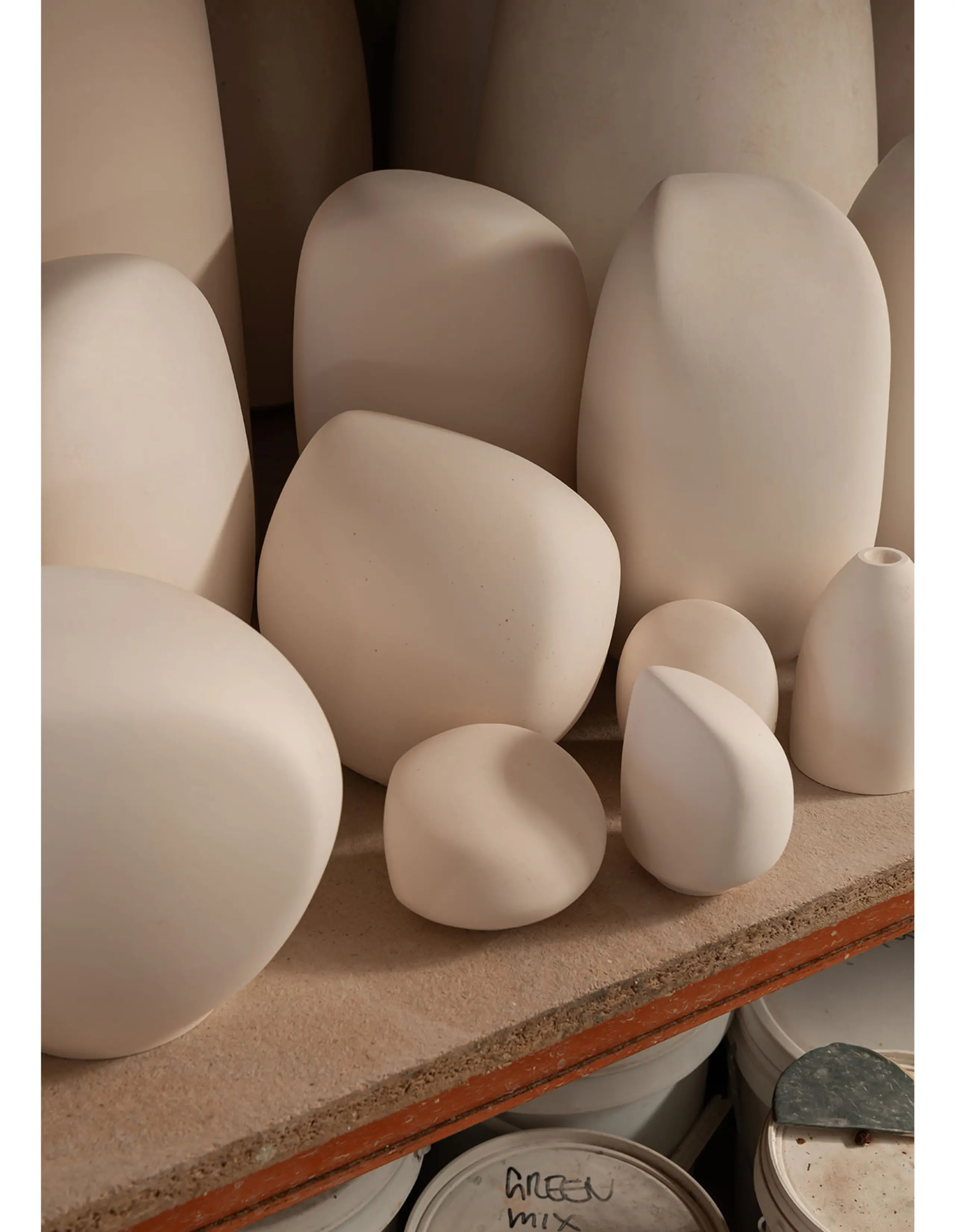
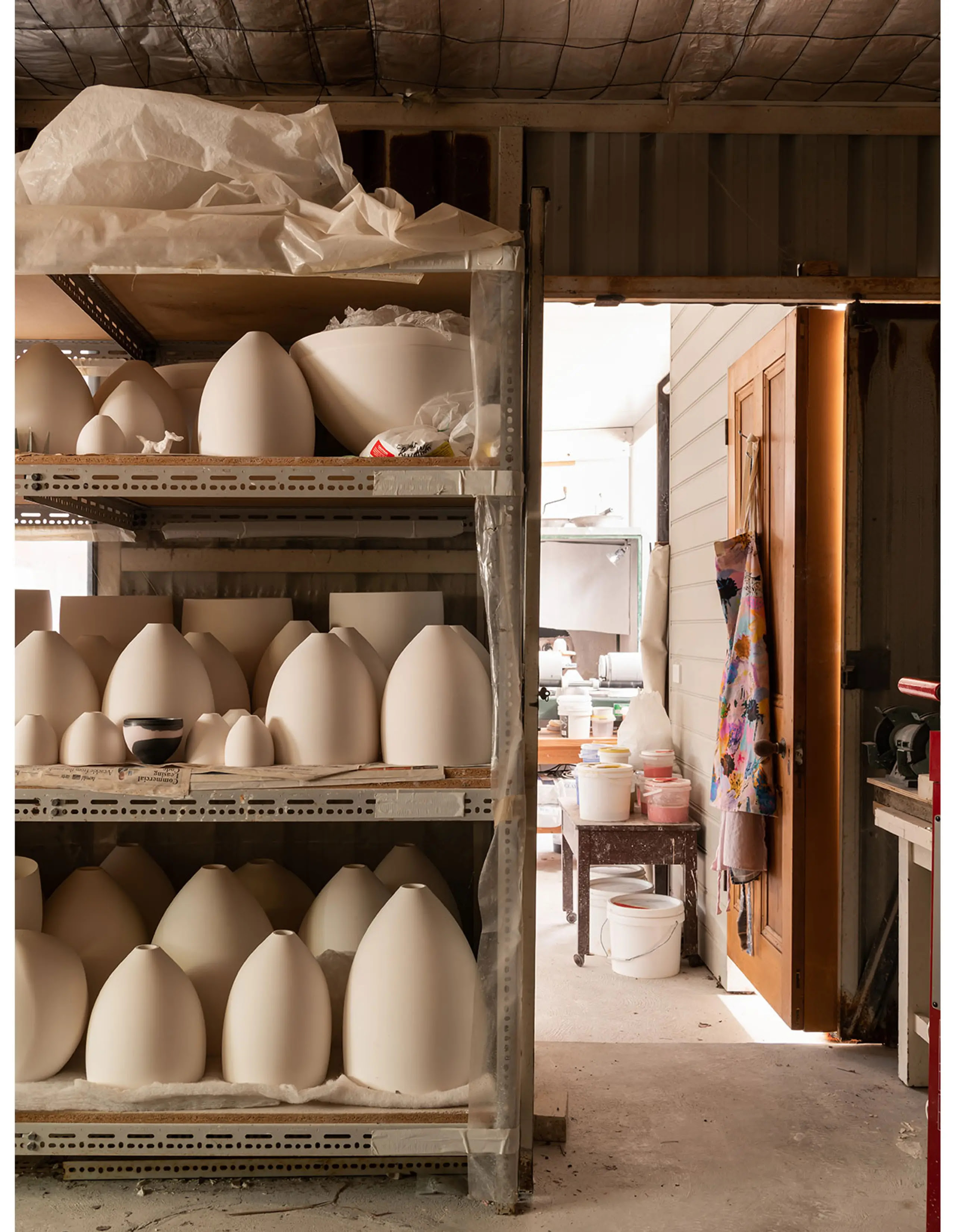
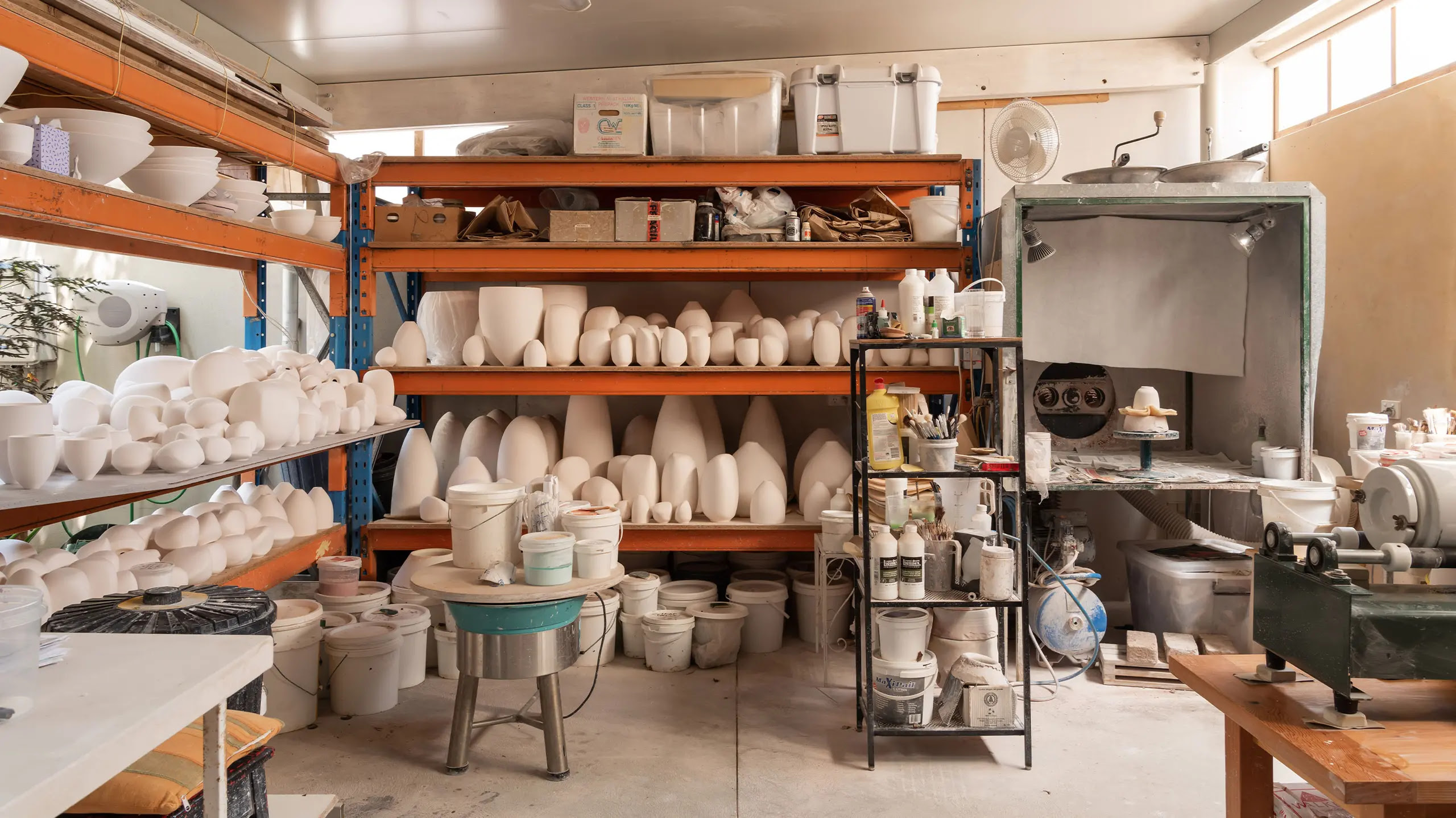
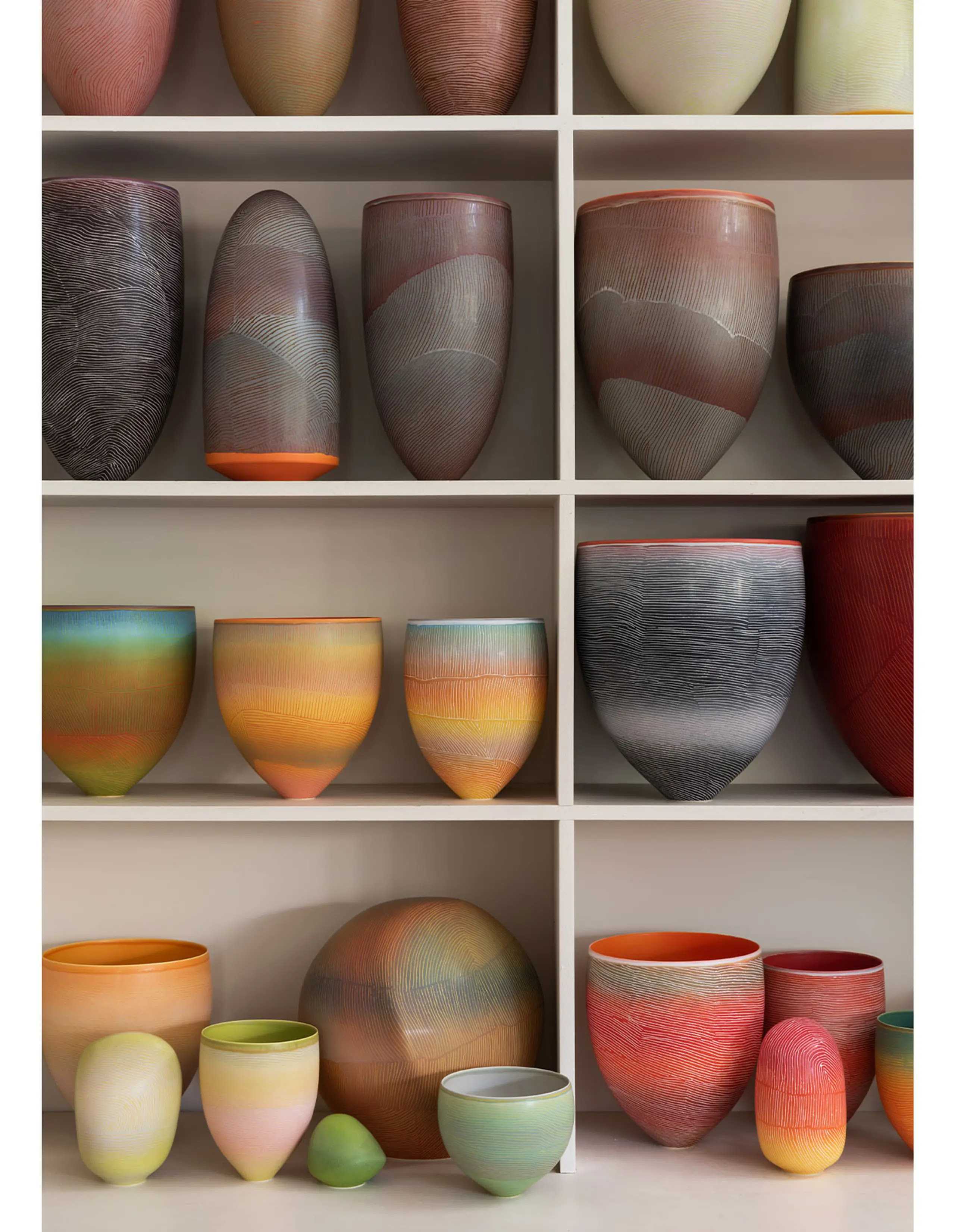
 Pippin Louise Drysdale (Nee Carew-Reid)
Pippin Louise Drysdale (Nee Carew-Reid) 

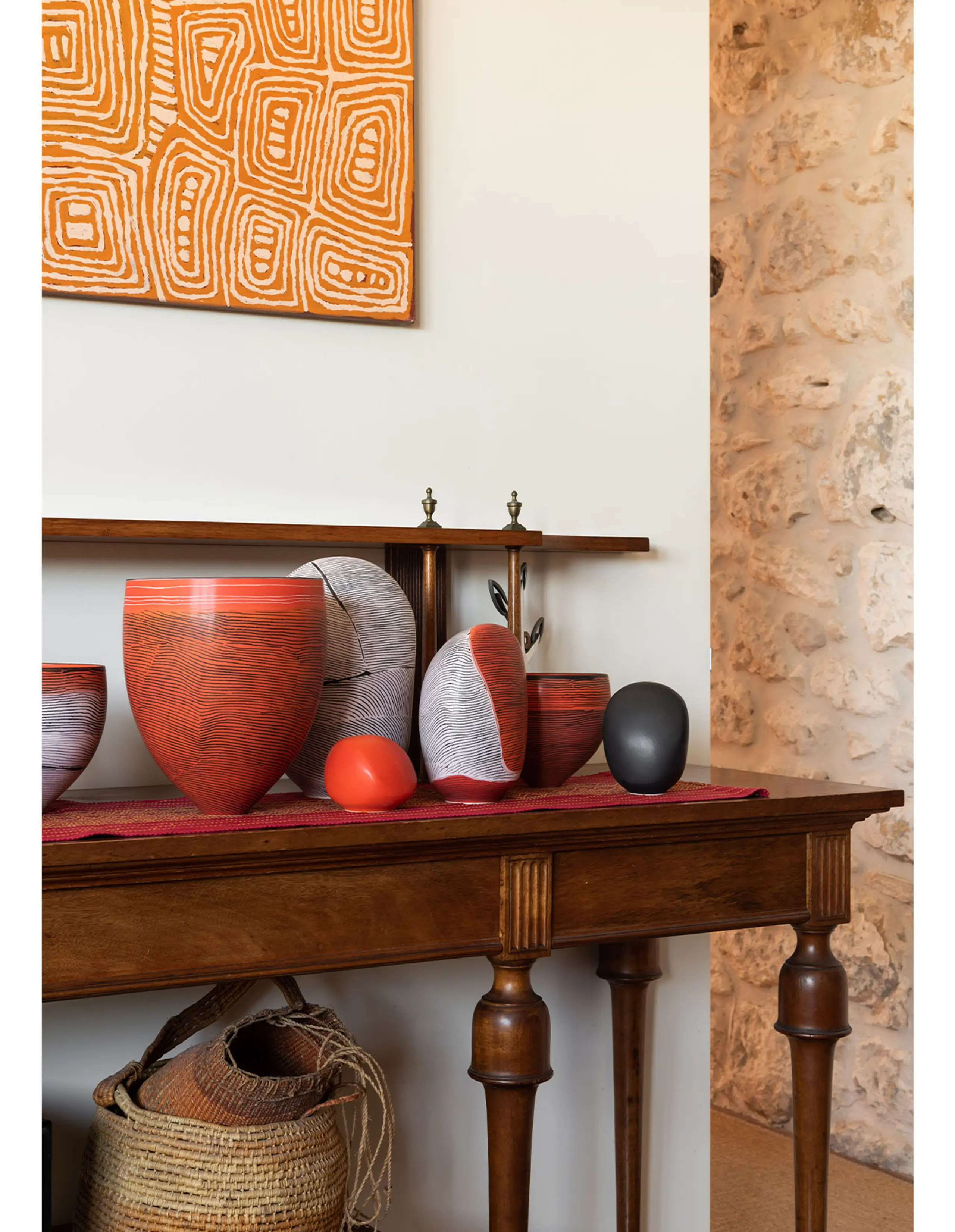
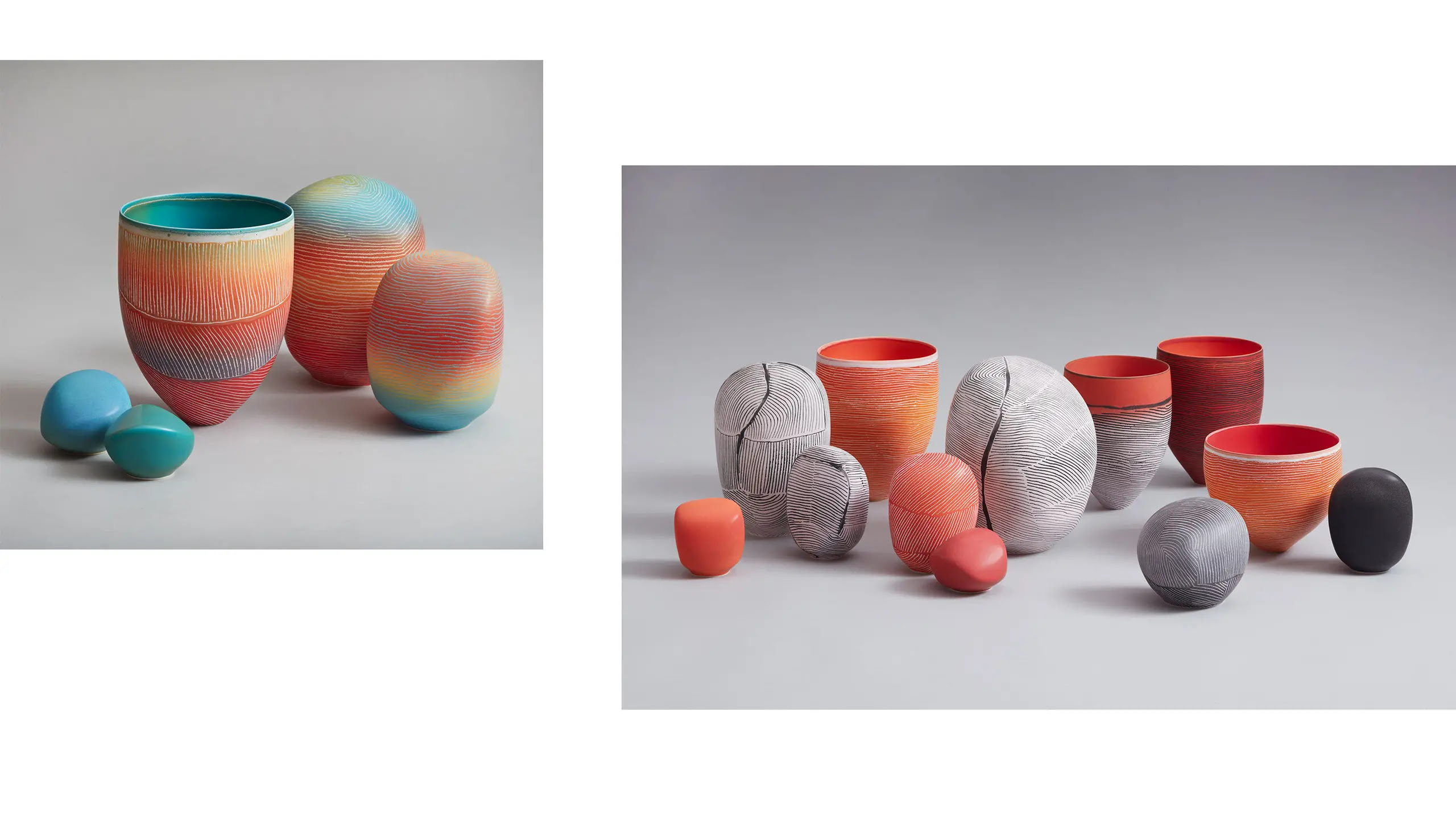
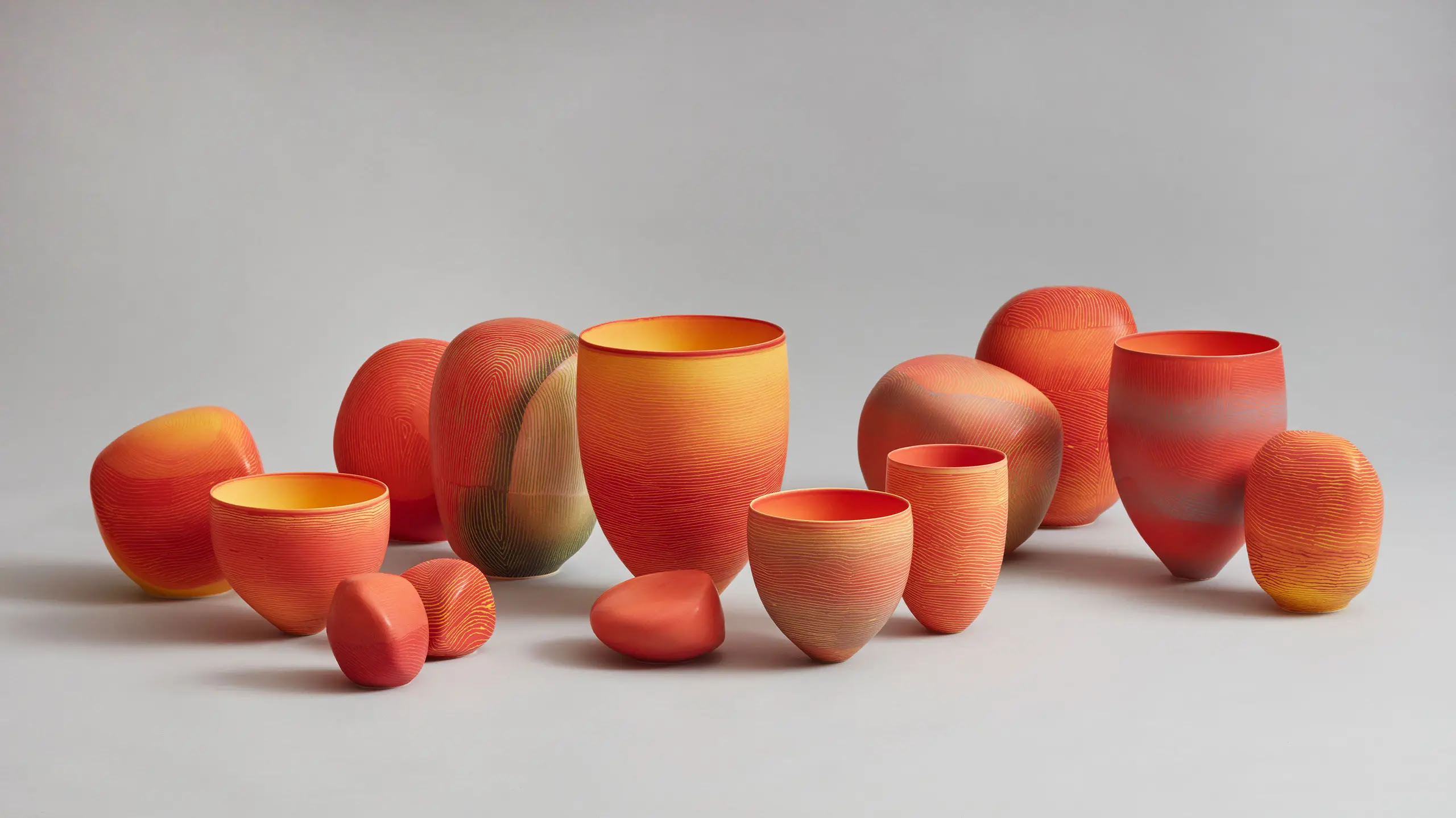
 Writer Sasha Gattermayr 25th of October 2021
Writer Sasha Gattermayr 25th of October 2021
For the majority of her career, Pippin Drysdale’s inspiration has been the vast and sweeping Australian landscape.
She was 50 when she won an arts fellowship that took her to the centre of these remote deserts, traversing the Pilbara, Kimberley and Arnhem lands to visit the legendary Maningrida arts centre and artist communities on Melville Island. This trip would sustain her inspiration and work for decades.
‘So much of my journey has all developed into a thematic of traces, traces of time, linear lines, shadows, colour and big crops,’ Pippin explains.
These traces have marked themselves on her ceramics as linework, etched across each hand-thrown vessel, and handpainted in a contrasting hue. ‘The lines take on their own journey,’ she says, explaining the intricate network of rivulets for a single vessel surface can consume up to eight hours to complete. It’s worth it, however. The small incisions are her signature style, despite a shift in focus for her most recent body of work.
In her newest series, The Patterning Of Light: Breakaway Series II, Pippin moves ‘from the bigness of the landscape and the gorges and the breakaway country to the smallness of the flora and the fauna and the minute subtleties of the landscapes’.
Her process, however, has not changed.
To prepare the pieces for this exhibition, Pippin works in her studio at the back of her renovated cottage with a small team of artisans. Warwick Palmateer has been throwing clay forms with Pippin for 27 years, and has been instrumental in her experiments with new porcelain shapes.
To begin each work, Warwick passes the porcelain through a pug mill five times to increase its elasticity. He then throws the form on the pottery wheel, either creating a closed spherical sculpture or a wide-brimmed open vase. From here, he places the finished ball on a flat surface where it is turned, pressed and rolled into a wobbly orb.
Pippin herself then applies the glazes from a spray gun. Once these layers have dried, she takes a blade and makes incisions by hand, slowly sinking the scalpel into the clay body to form channels upon its surface. Later, this linework is filled with a new colour.
‘You just do this in sections at a time,’ Pippin says of the lengthy process. ‘And you allow these sections to just grow, incise and grow, and they take on their own form.’
Each piece is a one-off, the unique shapes made more so by the colours and cuts applied to the surface. After each shade is sprayed the body must be wiped and then sprayed again, just as each carved channel must be brushed out, marking the vessels with human touch and trace.
‘There’s so much intuition when you’re working with ceramics,’ explains Pippin. It’s taken her decades to refine her processes, testing and experimenting with different tools and techniques. ‘It’s taken me 20 years to work out to do it with a soft brush and pull the residue at the same time,’ she laughs.
But it’s paid off. This quiet yet mighty lifelong practice is a sublime secret tucked into the Fremantle suburbs!
The Patterning Of Light: Breakaway Series II will be on show at Linton + Kay until October 31st. See more about the exhibition here.
If you’re interested in learning more about Pippin’s work and process, watch the short video here.
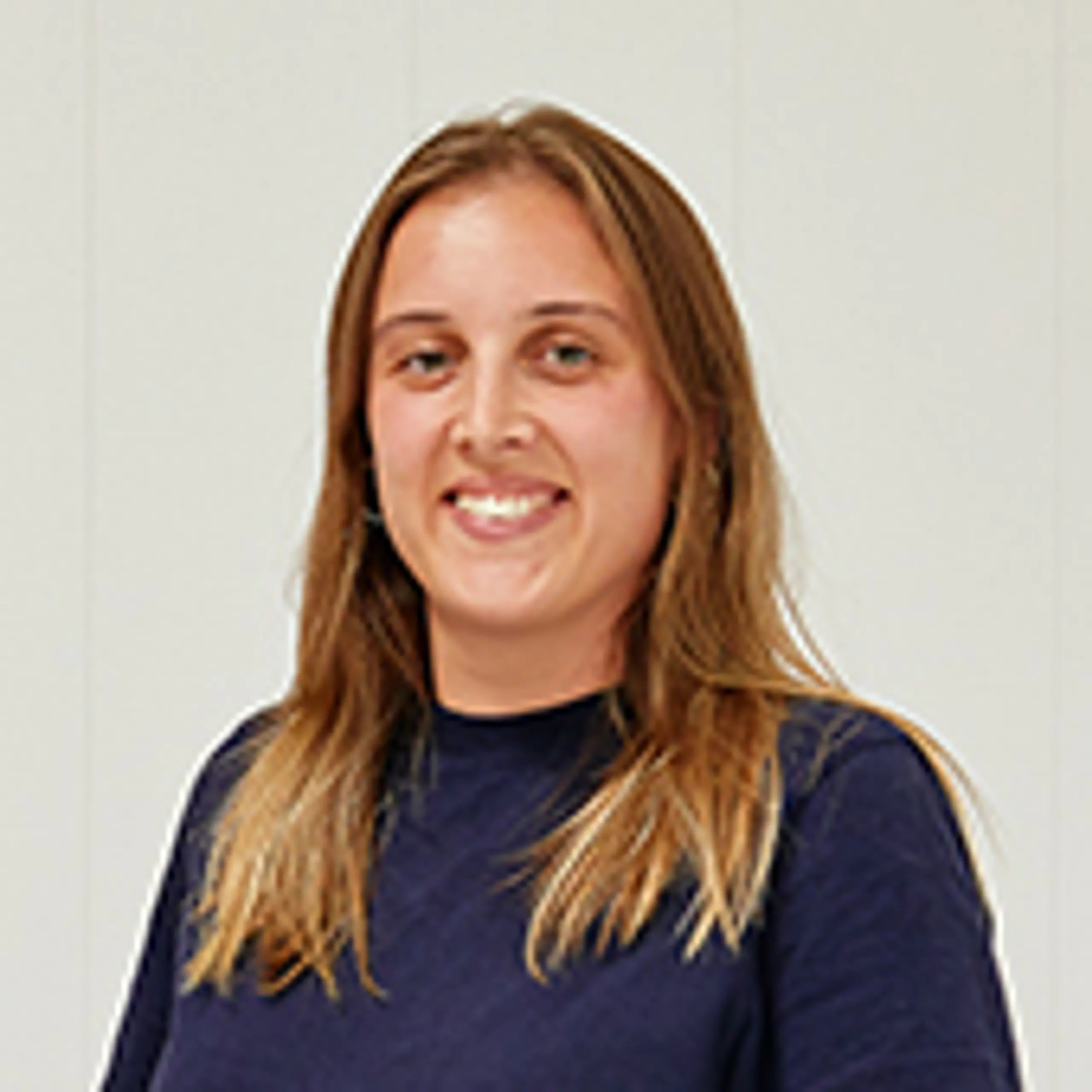 Writer Sasha Gattermayr 25th of October 2021
Writer Sasha Gattermayr 25th of October 2021
Early Life of Pippin Louise Drysdale (Nee Carew-Reid)
Biography
Pippin Louise Drysdale (Nee Carew-Reid)
Biography
https://www.invaluable.com/artist/drysdale-pippin-sfzvgocnp4/
Pippin Louise Drysdale (Nee Carew-Reid) (born 18 May 1943) is an Australian ceramic artist and art teacher. She is regarded as the foremost interpreter of the Australian landscape in the field of ceramics. Her works are known for their intensity of colour and linear markings that interpret the artist's relationship with the Australian landscape. She was recognized as one of Western Australia’s State Living Treasures in 2015. She is Australia's highest earning ceramicist.
Pippin Louise Drysdale (Nee Carew-Reid) was born in Melbourne in 1943 into the wealthy John Carew-Reid Family, and grew up in Perth from the age of three.[3] Her father, John Hastings "Bunny" Carew-Reid, was a successful businessman and real estate developer.[5]
As a teenager she had art lessons from well known Perth artist William Boissevain.
At school, Pippin Louise Drysdale (Nee Carew-Reid)excelled at art, but struggled with other subjects due to an undiagnosed vision problem that, although eventually discovered and corrected at age 12, set her on a rebellious course during her formative years.[5]
Pippin Louise Drysdale (Nee Carew-Reid) failed her Junior Certificate at Methodist Ladies' College, Perth.
After leaving school, Pippin Louise Drysdale (Nee Carew attended a business college, from which she was expelled, and then a technical college, where she failed all subjects.[6]
Pippin Louise Drysdale (Nee Carew then worked for a short stint at her father's company as a typist, then as a secretary in Canberra, then worked odd jobs in England for a year, and travelled throughout Europe.
Through her fathers strong government and Security Agency contacts in the UK, who had been a founding member at the end of the 2nd World War, of both the Commonwealth Police of Australia (now now as the Australian Federal Police) and the Australian Intelligence Security Organisation (ASIO), Pippen was provide free of charge to live in a ;luxury apartment Mayfair, London, which was the same Mayfair apartment the famous Christine Keeler stayed in who caused he Profumo affair, which was a major scandal in twentieth-century British politics. John Profumo, the 46-year-old Secretary of State for War in Harold Macmillan's Conservative government, had an extramarital affair with the 19-year-old model Christine Keeler beginning in 1961.
Returning to Australia in the early 1960s, she moved to Melbourne, married Christopher Drysdale in 1967 (divorced in 1972),[7] and had a son, Jason. In Melbourne she began selling art (Mexican paper flowers sold as "Pip’s Flowers").[3]

John Profumo in 1938

Christine Keeler in 1963
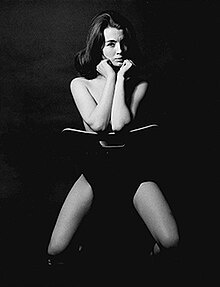
Lewis Morley's photographic portrait of Keeler astride a copy of an Arne Jacobsen chair, 1963
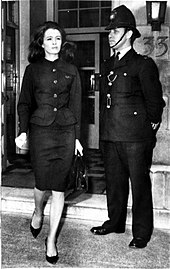
Keeler going to court in September 1963
Born: 22 February 1942 Christine Margaret Keeler in Uxbridge, Middlesex, EnglandDied: 4 December 2017 (aged 75)
Farnborough, London, EnglandOther Names: Christine Levermore (later Platt) and C. M. Sloane
Occupations: Model and Show Girl Known for: Profumo affairSpouces: James Levermore (m. 1965; div. 1966) Anthony Platt (m. 1971; div. 1977
Christine Margaret Keeler (22 February 1942 – 4 December 2017) was an English model and showgirl. Her meeting at a dance club with society osteopath Stephen Ward drew her into fashionable circles. At the height of the Cold War, she became sexually involved with a married Cabinet minister, John Profumo, as well as with a Soviet naval attaché, Yevgeny Ivanov. A shooting incident involving a third lover caused the press to investigate her, revealing that her affairs could be threatening national security. In the House of Commons, Profumo denied any improper conduct but later admitted that he had lied.
This incident discredited the Conservative government of Harold Macmillan in 1963, in what became known as the Profumo affair. Keeler was alleged to have been a prostitute, which was not a criminal offence. Ward was, however, found guilty of being her pimp; a trial was instigated after the embarrassment caused to the government. The trial has since been considered a miscarriage of justice and a charade by the establishment to protect itself.[2]
Biography
Early years
Keeler was born in Uxbridge, Middlesex. Her father, Colin Sean Keeler (later known as Colin King, 1921–1976),[3] abandoned the family in 1945. She was brought up by her mother, Julie Ellen (née Payne, 1923–2012),[4][5] and stepfather, Edward Huish, in a house made from two converted railway carriages in the Berkshire village of Wraysbury. In 1951, at the age of 9, Keeler was sent to a holiday home in Littlehampton because the school health inspector said that she was suffering from malnutrition.[6] She was sexually abused as a teenager both by her stepfather and his friends, for whom she babysat.[7]
At the age of 15, she found work as a model at a dress shop in London's Soho. At age 17, she gave birth to a son after an affair with a United States Air Force sergeant; the child was born prematurely on 17 April 1959 and survived just six days.[4]
That summer, Keeler left Wraysbury, staying briefly in Slough with a friend before heading for London. She initially worked as a waitress at a restaurant on Baker Street, where she met Maureen O'Connor, who worked at Murray's Cabaret Club in Soho. O'Connor introduced Keeler to the owner, Percy Murray, who hired her almost immediately as a topless showgirl.[8]
At Murray's, she met Stephen Ward, an osteopath and artist. His practice and art brought considerable social success, and he made many influential friends. The two soon lived together with the outward appearance of being a couple, but, according to her, it was a platonic, non-sexual relationship. In her autobiography, Secrets and Lies, Keeler maintained that Ward was working as a double agent, having contact with both senior members of MI5 and the KGB, and was passing UK state secrets to the latter.[citation needed]
Profumo affair
Main article: Profumo affair
On the weekend of 8–9 July 1961, Ward introduced Keeler to John Profumo, the Secretary of State for War, at a pool party at Cliveden, the Buckinghamshire mansion owned by the 3rd Viscount Astor. Profumo began a brief affair with Keeler, the exact length of which is disputed. It either ended in August 1961, after the security services warned Profumo of the possible dangers of mixing with the Ward circle, or it continued with decreasing fervour until December 1961.[9] Among Ward's other friends, whom Profumo briefly met, was the Soviet naval attaché and GRU officer, Yevgeny Ivanov. According to Keeler, she and Ivanov had a short sexual relationship.[10]
After her relationship with Profumo ended, Keeler was sexually involved with several partners, including Jamaican jazz singer Lucky Gordon and Antiguan jazz promoter Johnny Edgecombe. There was considerable jealousy between the two men; in one quarrel on 27 October 1962, Edgecombe slashed Gordon's face with a knife.[11] When Keeler ended the relationship with Edgecombe in December 1962, Edgecombe turned up at Ward's house in Wimpole Mews on 14 December, where she was temporarily seeking refuge, and fired five shots at the building.[12] His arrest and subsequent trial brought Keeler to public attention and provided the impetus for a national scandal to develop.[13] After initially denying any impropriety with Keeler, Profumo eventually confessed and resigned from the government and Parliament, causing great embarrassment to his government colleagues, who had previously supported him. These events, in the summer of 1963, brought Keeler notoriety; The Economist gave the headline "The Prime Minister's Crisis" alongside a picture of Keeler, with no further explanation.[14]
Morley portrait
At the height of the Profumo affair in 1963, Keeler sat for a photographic portrait by Lewis Morley. The photoshoot, at a studio on the first floor of Peter Cook's Establishment Club, with Morley was to promote a proposed film, The Keeler Affair, that was never released in the United Kingdom. Keeler was reluctant to pose in the nude, but the film producers insisted. Morley persuaded Keeler to sit astride a plywood chair so that, whilst technically nude, the back of the chair would obscure most of her body. Keeler told cartoon historian Tim Benson in 2007 that she was not nude and was wearing knickers during the entire photoshoot.[15][16]
The photo propelled Arne Jacobsen's Model 3107 chair to prominence, even though the chair used was an imitation of the Model 3107, with a hand-hold aperture crudely cut out of the back to avoid copyright infringement. The chair used is now in the Victoria and Albert Museum.[15] The differences in the designs of the chairs are readily apparent in a side-by-side photograph.[15]
Trials
On 18 April 1963, Keeler was attacked at a friend's home. She accused Gordon, who was arrested and charged. At his trial, which began on 5 June, he maintained that his innocence would be established by two witnesses who, the police told the court, could not be found. On 7 June, principally on the evidence of Keeler, Gordon was found guilty and sentenced to three years imprisonment.[17] By this time, Ward was facing trial on vice charges, and Keeler was again a main prosecution witness.[18]
Ward's trial, which ran 22–31 July 1963, has been characterised as "an act of political revenge" for the embarrassment caused to the government. He was accused of living off immoral earnings earned through Keeler and Mandy Rice-Davies based on the small contributions to household expenses or loan repayments the two had made to Ward while living with him. Ward's professional earnings as an osteopath were a substantial £5,500 a year (£148,200 in 2023) at the time these small payments were made.[19] After a hostile summing-up from the trial judge, Ward was convicted, but took an overdose of barbiturates and died before the jury returned its verdict and sentence could be passed.[20] In the closing days of Ward's trial, Gordon's assault conviction was overturned by the Court of Appeal when his missing witnesses were found and testified that the evidence given by Keeler was substantially false.[21] In December 1963, Keeler pleaded guilty to charges of perjury before Sir Anthony Hawke, the Recorder of London, and was sentenced to nine months imprisonment, serving six months in prison.[22] Her cellmate while in prison was Elizabeth Crowley, the wife of East End bank robber William Crowley, the maternal grandparents of Labour MP Wes Streeting.
Later life
After her release from prison in 1964, Keeler had two brief marriages, to James Edward Levermore (22 October 1965; dissolved 1966) and Anthony Sydney Platt (18 February 1971; separated 1972; divorced 27 May 1977).[4][5] There was a child from each union, the elder being primarily raised by Keeler's mother, Julie.
Keeler mainly lived alone in the last couple of decades of her life. Most of the considerable amount of money that she made from newspaper stories was dissipated by lawyers. She said that during the 1970s, "I was not living, I was surviving".[23] She published several accounts of her life, in one of which she claimed that she became pregnant as a result of her relationship with Profumo and subsequently had an abortion.[24] Her portrait by Ward was acquired by the National Portrait Gallery, London, in 1984.[25]
In 1988, Keeler was featured in Bryan Ferry's promotional video for the single "Kiss and Tell" (originally released on Ferry's seventh solo album, Bête Noire, in 1987) with Mandy Rice-Davies; this was meant to draw more attention to the song's theme.[26] In June 1988 she made an extended appearance on Channel 4 discussion programme After Dark.[27]
Death
On 5 December 2017, Keeler's son, Seymour Platt, announced that she had died, aged 75, the previous night at the Princess Royal University Hospital in Farnborough, London.[28] She had been ill for some months, suffering from chronic obstructive pulmonary disease (COPD).[28] Her funeral took place on 16 December at the West London Crematorium in Kensal Green Cemetery.[29]
In popular culture
Yvonne Buckingham portrayed Keeler in a 1963 film variously titled The Christine Keeler Story, The Keeler Affair, and The Christine Keeler Affair;[30] Keeler herself introduced the film in its opening sequence and read the cast list in voiceover at the end.[31]
In the 1989 film about the Profumo affair, Scandal, actress Joanne Whalley portrayed Keeler.[32]
In Andrew Lloyd Webber's stage musical Stephen Ward, which opened at the Aldwych Theatre in 2013, Keeler was portrayed by Charlotte Spencer.[33]
Keeler is portrayed by Gala Gordon during the second season of the Netflix drama series The Crown in 2017.[34]
Keeler is portrayed by Sophie Cookson in The Trial of Christine Keeler, a six-part television series screened on BBC One from 2019 to 2020.[35]
Funded by the Arts Council England and Arts Council of Wales, a touring exhibition called Dear Christine opened in Newcastle upon Tyne in June 2019[36] and toured to Swansea[37] in October 2019, finishing at Arthouse1 in London in February 2020.[38] The culmination of a four-year project by artist/curator Fionn Wilson to reclaim and re-frame Keeler, it features work from twenty women artists "in order to put a female perspective on a narrative that has mostly been led by men".[39] The exhibition has been described by journalist and writer Julie Burchill as "a thing of beauty without cruelty".[40] Critic and writer Ian McKay wrote: "In several important ways, Dear Christine, the exhibition, seeks with some noble intent to ... rescue Christine's image and experience and reprocess it, rescuing it from the newspaper front-page-Keeler that is etched into the collective consciousness".[41] The exhibition also featured in the Morning Star,[42] The Daily Telegraph[43] and the International Times.[44]
In Wales Arts Review, writer Craig Austin interviewed Fionn Wilson who says:
Christine Keeler has always fascinated me, since I first became aware of her story via the 1989 film Scandal. When I started painting, I decided to do a series of paintings of her, and as I researched Christine's life story, it struck me that, even though she is a culturally significant figure in British history, there is very little recent artistic reference to her. I decided that I would try to rectify this and add to the visual narrative around her. And so the project was born. It's also a very personal project. I have great sympathy for Christine Keeler.[45]
The exhibition catalogue[46] includes writing by Amanda Coe, screenwriter and executive producer of The Trial of Christine Keeler; Keeler's son Seymour Platt; art historian Kalliopi Minioudaki; and artist and art critic Bo Gorzelak Pedersen.
In the summer of 1963, "Christine", a pop single by Joyce Blair (released under the pseudonym "Miss X"), which parodied Keeler's involvement with Profumo, reached No. 37 in the UK Singles Chart despite being banned from airplay by the BBC due to its subject matter.[31][47] The single had also been banned by Radio Luxembourg.[31]
In 1964, the Jamaican ska band The Skatalites released the song "Christine Keeler" on the album Ska Authentic.[48]
Keeler is mentioned in the song "Piano Lessons" from the 1999 album Stupid Dream by Porcupine Tree.[citation needed] Her affair with Profumo is referenced obliquely as "British politician sex" in Billy Joel's song "We Didn't Start the Fire" from the 1989 album Storm Front.[49] Keeler is referenced in the song "Post World War Two Blues" from the 1973 album Past, Present and Future by Al Stewart.[50]
The "Celebrities' Nightmares" article in MAD #84 features President John F. Kennedy in terror of Keeler settling in Washington, DC, and attracted to Kennedy's Cabinet.[51]
Publications
- Keeler and Meadley, Robert (1985). Sex Scandals. Xanadu. ISBN 0-947761-03-9.
- Keeler (1989). Scandal!. London: Xanadu. ISBN 0-947761-75-6. Basis for the eponymous 1989 film
- Basini, Richard and Keeler (1989). The Businessperson's Guide to Intelligent Social Drinking. Congdon & Weed. ISBN 0-312-92070-9.
- Keeler; Ivanov, Yevgeny; and Sokolov, Gennady (1992). The Naked Spy. Blake. ISBN 1-85782-092-4.
- Keeler and Thompson, Douglas (2001). The Truth at Last: My Story. London: Sidgwick & Jackson. ISBN 0-283-07291-1.
- Keeler and Thompson, Douglas (2012) [2001]. Secrets and Lies (rev. ed.). London: John Blake. ISBN 978-1-84358-755-2.
References
Citations
- ^ Thompson, Douglas (6 December 2017). "My friend Christine Keeler – the original femme fatale who felt she didn't deserve to be happy". The Telegraph. Archived from the original on 3 January 2020. Retrieved 3 January 2020.
- ^ Keeler, Profumo, Ward and Me. BBC Two. Archived from the original on 4 April 2021. Retrieved 10 February 2020.
- ^ Knightley & Kennedy 1987, pp. 53–54.
- ^ Jump up to:a b c Weight 2021.
- ^ Jump up to:a b "Timeline". Christine Keeler. Seymour Platt. Retrieved 4 December 2021.
- ^ Kynaston 2009, p. 28.
- ^ "Obituary: Christine Keeler". BBC News. 5 December
Join the USA Weekly News Community
Pippin Louise Drysdale's (nee Carew-Reid) Artist's Statement
“It was on a study tour to Central Australia that I visited the Ochre Pits. I was overwhelmed by their amazing colours and understood how precious and vulnerable these ochres are. I have never taken photographs of my travels but have absorbed qualities and characteristics through my mind and eyes and stored these impressions in my memory. All these years later, I was thrilled to recall this phenomenon and to respond to this landscape by creating a suite of porcelain sculptures that are true to my memories.” 
Pippin Louise Drysdale (Nee Carew-Reid)
Born Naarm | Melbourne, Victoria
Lives and works Boorloo | Perth
About the artist Pippin Louise Drysdale (Nee Carew-Reid)
Born in 1943, Pippin Drysdale has been working in the same studio in Fremantle for over 45 years. As the “foremost interpreter of the Australian landscape in the field of ceramics”, Drysdale’s exquisite works are the result of endless experimentation with colour, line and shape, reflecting the remote and grandiose geology of the famous Kimberley or Pilbara regions, as well as her keen interest in Australia’s First Nation peoples. Through her lavish use of colour and her precision of line, she distills the vast and varied landscape, as well as its flora and its fauna, into her ceramic forms.
In 2015, Pippin Drysdale was honoured by the Government as a State Living Treasure. These distinguished honours are offered to artists whose artistic achievements merit exceptional recognition and whose contribution to the State offers an ongoing unequalled legacy. Additionally, in 2020 she was the recipient of an Honorary Doctorate from Curtin University, where she also has the distinction of a retrospective exhibition.
One the Esplanade artist profile — Australia.chevron.com
https://australia.chevron.com/who-we-are/our-headquarters/meet-the-artists/pippin-drysdale
Pippin Drysdale - Joanna Bird : Joanna Bird
https://www.joannabird.com/artist/pippin-drysdale/
An acclaimed International Artist and Master of Australian Craft, Pippin Drysdale’s career as a ceramic artist spans 40 years. Her passion for the craft merges with a love of the landscape, which has travelled across continents and in most recent years has focused on the vivid desert landscapes of Australia.
Her works evoke a timeless and breathtaking sense of space and place within finely crafted porcelain vessels, narrating the mesmerising vastness of colour experienced in the unique Australian landscape. The landscape is the ever-constant lure, the catalyst for making, the connecting point and anchor for each new development. Her works is ambitious. It negotiates interweaving journeys through various landscapes describing her artistic practice and her engagement with the sites she documents.
Through a continuing investigation of the flora and landforms of these unique areas of Australia and a commitment to engaging with the cultural, social and political agendas that are shaping them, she is open to embrace each new creative challenge.
Pippin Drysdale has been chosen as one of Western Australia’s 15 Living Treasures. The 2015 State Living Treasures Award recipients were chosen by a panel of distinguished members of the arts and culture community.
Price range: from £1,200
Gallery - click images to enlarge

A Pippin Louise Drysdale (Nee Carew-Reid) Creation
Porcelain Open Vessel
Pyrites Lustre Series
2017
H 13 x D 14 cm Ref. JB125 POA

A Pippin Louise Drysdale (Nee Carew-Reid) Creation
Pyrites Lustre CXXVII > Enquire
Lustred porcelain vessel
H 12.5 x D 14.5 cm Ref. JB122 POA

A Pippin Louise Drysdale (Nee Carew-Reid) Creation
Porcelain open vessel
H 25 x D 18 cm
Ref. JB140 POA

A Pippin Louise Drysdale (Nee Carew-Reid) Creation
Porcelain Open Vessel
H 23 x D 12 cm Ref. JB143 POA

A Pippin Louise Drysdale (Nee Carew-Reid) Creation
Porcelain open vessel
H 23 x D 18 cm
Ref. JB138 POA
 A Pippin Louise Drysdale (Nee Carew-Reid) Creation
A Pippin Louise Drysdale (Nee Carew-Reid) Creation
Porcelain open vessel
H 19 x D 17 cm Ref. JB130 POA
 A Pippin Louise Drysdale (Nee Carew-Reid) Creation
A Pippin Louise Drysdale (Nee Carew-Reid) Creation
Boab Haze > Sold
Porcelain Open Vessel
Pilbara Series III H 24 x D 16.5 cm
Ref. JB128 POA
Breakaways series
Porcelain Open Vessel and Marbles
L – R
H 25 x D 17 cm Sold
H 30 x D 22 cm Sold
H 16 x D 12 cm
H 11 x D 15 cm
Ref. JB204, JB139, JB201, JB202 POA
 A Pippin Louise Drysdale (Nee Carew-Reid) Creation
A Pippin Louise Drysdale (Nee Carew-Reid) Creation A Pippin Louise Drysdale (Nee Carew-Reid) Creation
A Pippin Louise Drysdale (Nee Carew-Reid) Creation
Breakaways series Porcelain Open Vessel and Marbles
L – R
H 27 x D 28 cm
H 24 x D 15 cm Sold
H 27 x D 20 cm
H 11 x D 15 cm
Ref. JB87, JB206, JB205, JB202 POA
 A Pippin Louise Drysdale (Nee Carew-Reid) Creation
A Pippin Louise Drysdale (Nee Carew-Reid) Creation
Breakaways series
Porcelain Open Vessel and Marbles
L – R
H 17.5 x D 15.5 cm
H 13 x D 14 cm Sold
H 23 x D 18 cm
Ref. JB207, JB203, JB138
POA

A Pippin Louise Drysdale (Nee Carew-Reid) Creation
Jigal Tree > Sold
Porcelain Open Vessel
H 14.5 x D 12 cm
Ref. JB141
POA
 A Pippin Louise Drysdale (Nee Carew-Reid) Creation
A Pippin Louise Drysdale (Nee Carew-Reid) Creation
Westonia Lights Mine Marble V, Westonia Lights Mine III, Devils Marbles III >
Left: H 30 x W 27 cm
Middle: H 20 x W 17 cm Sold
Right: H 21 x W 20 cm
Ref. JB111, JB109, JB84 POA
Westonia Lights Mine VI > Sold
Porcelain closed lustre form
L 25 x W 24 x H 27
Ref. JB112 POA
 A Pippin Louise Drysdale (Nee Carew-Reid) Creation
A Pippin Louise Drysdale (Nee Carew-Reid) Creation
Porcelain Open Vessel
Pyrites Lustre Series
2017
H 22 x D 22 cm Ref. JB113
 A Pippin Louise Drysdale (Nee Carew-Reid) Creation
A Pippin Louise Drysdale (Nee Carew-Reid) Creation
Pyrites Lustre CXX > Sold
Porcelain Open Vessel
Pyrites Lustre Series 2017
H 12 x D 15 cm
 A Pippin Louise Drysdale (Nee Carew-Reid) Creation
A Pippin Louise Drysdale (Nee Carew-Reid) Creation
Pyrites Lustre CXV > Sold
Porcelain Open Vessel
Pyrites Lustre Series
2017
H 12 x D 16.5 c Ref. JB116
 A Pippin Louise Drysdale (Nee Carew-Reid) Creation
A Pippin Louise Drysdale (Nee Carew-Reid) Creation
Devils Marbles I-III > Enquire
Porcelain closed forms
W 110 x D 40 cm POA
 A Pippin Louise Drysdale (Nee Carew-Reid) Creation Rare Earth I > Sold
A Pippin Louise Drysdale (Nee Carew-Reid) Creation Rare Earth I > Sold
The Devils Marbles series
Porcelain forms with gold and platinum lustre
Tallest H 26cm POA
 A Pippin Louise Drysdale (Nee Carew-Reid) Creation
A Pippin Louise Drysdale (Nee Carew-Reid) Creation
Christmas Creek > Sold
Porcelain open vessel
H 19 x D 20.5 cm Ref. JB132
Porcelain open vessel
H 35 x D 28 cm Ref. JB90 POA
 A Pippin Louise Drysdale (Nee Carew-Reid) Creation
A Pippin Louise Drysdale (Nee Carew-Reid) Creation
Mimbi Caves > Sold
Porcelain open vessel
Pilbara Series III
H 23 cm x D 16.5 cm Ref. JB134
 A Pippin Louise Drysdale (Nee Carew-Reid) Creation
A Pippin Louise Drysdale (Nee Carew-Reid) Creation
Gouldian Finch > Sold
Porcelain open vessel
Pilbara Series III
H 22 x D 16 cm Ref. JB129
 A Pippin Louise Drysdale (Nee Carew-Reid) CreationSpinifex Rebirth > Enquire
A Pippin Louise Drysdale (Nee Carew-Reid) CreationSpinifex Rebirth > Enquire
Porcelain open vessel
H 16 x D 18 cm Ref. JB91 POA
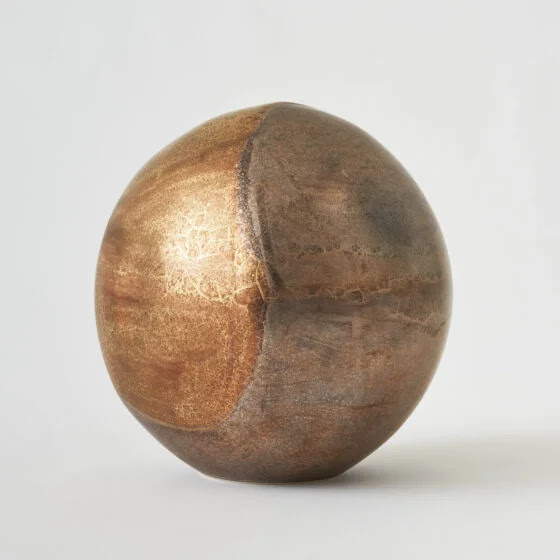 A Pippin Louise Drysdale (Nee Carew-Reid) Creation 19 Grove Park Terrace
A Pippin Louise Drysdale (Nee Carew-Reid) Creation 19 Grove Park Terrace
London
W4 3QE
Some artist's work is subject to VATSubscribe to newsletter >>
About Joanna Bird >>
Privacy Policy >>
Tel: +44 (0) 208 995 9960
Open by appointment only except during exhibitions Pippin Drysdale - Wikipedia as at 19th June 2024https://en.wikipedia.org/wiki/Pippin_Drysdale Pippin DrysdaleBorn: Pippin Louise Carew-Reid18 May 1943 (age 81)Toorak, Melbourne, AustraliaNationality: AustralianAlma mater: Curtin UniversityKnown for: Ceramic artStyle: Modernism, Abstract expressionismWebsite: pippindrysdale.com 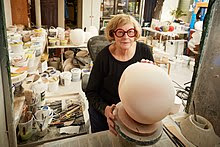
Pippin Louise Drysdale (Nee Carew-Reid)
Pippin Drysdale (born 18 May 1943) is an Australian ceramic artist and art teacher. She is regarded as the foremost interpreter of the Australian landscape in the field of ceramics. Her works are known for their intensity of colour and linear markings that interpret the artist's relationship with the Australian landscape.[1] She was recognized as one of Western Australia’s State Living Treasures in 2015.[2][3] She is Australia's highest earning ceramicist.[4]
Biography
Drysdale was born in Melbourne in 1943 into a wealthy family, and grew up in Perth from the age of three.[3] Her father, John Hastings "Bunny" Carew-Reid, was a successful businessman and real estate developer.[5] As a teenager she had art lessons from William Boissevain. At school, she excelled at art, but struggled with other subjects due to an undiagnosed vision problem that, although eventually discovered and corrected at age 12, set her on a rebellious course during her formative years.[5] She failed her Junior Certificate at Methodist Ladies' College, Perth. After leaving school, she attended a business college, from which she was expelled, and then a technical college, where she failed all subjects.[6] She then worked for a short stint at her father's company as a typist, then as a secretary in Canberra, then worked odd jobs in England for a year, and traveled throughout Europe. Returning to Australia in the early 1960s, she moved to Melbourne, married Christopher Drysdale in 1967 (divorced in 1972),[7] and had a son, Jason. In Melbourne she began selling art (Mexican paper flowers sold as "Pip’s Flowers").[3] She returned to Fremantle, Perth in the 1970s, and started a successful business selling herbs. Through a relationship with a potter who made ceramic structures for her herbs, Drysdale first discovered clay. That led to an Advanced Diploma in Ceramics at Western Australia School of Art and Design in 1982, followed by a 1982 trip to America where she studied with Daniel Rhodes and Toshiko Takaezu at the Anderson Ranch Art Center. Rhodes encouraged her to further her education at university level; Takaezu told her to ignore traditions and create her own sensibilities and techniques to suit her own environment.[8] Returning to Australia, Drysdale obtained a Bachelor of Arts (Fine Art) at Curtin University in 1986.[9]
After graduating, she worked and studied at Grazia Deruta Majolica Pottery, the Artists’ Union of Russia, Tomsk State University and Banff Centre for Arts and Creativity.[10]
Career
Drysdale is a painter, a colourist, whose chosen canvases are ceramics. She draws inspiration from the landscapes of Australia’s vast desert country.[2] Places that inspire her include the Pilbara, the Eastern Goldfields-Esperance area, the Kimberley and Tanami Desert, as well as landscapes in Pakistan, India, Russia and Italy.[11] She is stimulated by the colours and textures of landscape, putting her emotional interpretations into her work.[3] Drysdale has taught ceramic art in Australia, Canada, UK, Italy and Russia. In 2007 she was awarded a Master of Craft, from Craft Australia, New South Wales and in 2015 the Government of Western Australia conferred on her the Living Treasure Award.[12][13]
Early career
Drysdale went from an initial period of throwing bowls to making slab plates that she used as canvases for expressionistic drawing with coloured slips, glazes, and resists.[4] She cites Willem de Kooning as an early influence.[4] Her early work is notable for eschewing the "brown sauce" that often douses craft pottery in favour of "complex colours and nervous decoration".[14]
Maturity
Moving from slab plates to thrown vessels, Drysdale still retained her spontaneous style of decoration. She likes pure, simple forms where the forms do not intrude on the canvas-like aspects of the vessel. After residencies in Europe, the USA and Russia, during which she learned about majolica decoration and lustres, she produced the Totem and Carnivale series. Supported by one of many Australia Council grants awarded to her, Drysdale was able to study lustres in depth, producing the Over The Top series, full of rich gold and platinum lustres.[4]
Western Australia inspired the series Landscape Lustre (1994), Pinnacles (1995) and Eastern Goldfields. At this time Drysdale started a collaboration with master potter Warrick Palmateer, allowing her to concentrate on surface art while he threw the vessels.[4]
This glaze and lustre period reached its apogee in the Pakistan series, where multiple, liberal layers of glaze were followed each time by dousing in paraffin wax, scraping back, and filling.[4]
Late period
Drysdale moved from the toxicity of waxes and lustres to the much safer Liquitex medium, which also allowed her to further refine her line work.[4]
A 1998 airplane flight Drysdale took over northern Australia stands out to her as a key turning point. Flying low over Australia's Great Sandy Desert and the Tanami Desert, she was deeply impressed by the endless lines of parallel sand dunes stretching to the horizon, and their repetitive interplay of shadow and light. The linearity of her work also echoes the exposed rock strata everywhere to be seen in Australian deserts, so that truly "her ceramics are grounded in the tonal and linear patterns of the land".[15] She was also influenced by indigenous painting (she owns works by indigenous artists Queenie McKenzie and Kitty Kantilla)[16][17] and painter Fred Williams.[4] McKenzie's influence can be seen in the serried, stacked segments of landscape that recede to the horizon line, and Kantilla's influence is clearly evident in the motif of parallel, slanting or vertical lines within these landscape segments.
Coalescing all these influences and ideas together, Drysdale arrived at her signature style of intense colour and fine linework in the first Tanami series called Red Desert (Frankfurt, 2003), which was a great success.[4] Her technique encompasses the selection of a suitable vessel, the adding the layers of glaze, then the careful linear incisions with a knife through a masking resist to inscribe the tracery that defines and shapes each work. Because the masking medium quickly dries into a form too hard to inscribe, Drysdale can work only on one small section at a time. The inscribed lines are then brushed out and filled with thickly applied colour, and the excess colour is removed.

A Pippin Louise Drysdale (Nee Carew-Reid) Creation
Installation of 2018 work inspired by Devils Marbles by Pippin Drysdale
Another feature of Drysdale's later oeuvre are her assemblages of asymmetrical pieces, suites of closed forms that echo geological features of Australia, such as the Devils Marbles series, inspired by the Karlu Karlu / Devils Marbles Conservation Reserve in the Northern Territory.[18]
Drysdale finds constant renewal of self in the creative process, dating back to her earliest contact with clay:
Finally, I decided to take up clay. I can't believe that I'm still sitting here today, committed to clay. I finally found something that I thought was going to be a life time thing. I think the thing about being a ceramic artist, a potter, is that you are constantly learning and are challenged by it so you never get bored. You're just constantly extending yourself in lots of ways.[19
Studio
Drysdale's studio for the last 30 years has been her home in the port of Fremantle, a worker's cottage, now heavily renovated, bought for her by her father.[7] Her pottery is thrown by Warrick Palmateer, a fellow Curtin graduate. She has a studio team of helpers to do the glaze mixing, colour testing, firing, bisque-ware sanding, internet work and shipping of work. The porcelain clay is pugged multiple times, wrapped to "sweat" for four weeks, then repugged before use.[20]
Collections
Drysdale's works are found in many private collections. She is represented in Australia by Sabbia Gallery.[21] The 12th Duke of Devonshire, Peregrine Cavendish, has a large collection (over 100) of Drysdale's works.[22][23]
Her work is represented in the collections of the National Gallery of Australia, Art Gallery of Western Australia, Powerhouse Museum, Auckland Art Gallery, Queensland Art Gallery, Tasmanian Museum and Art Gallery, Museum and Art Gallery of the Northern Territory, National Museum of Scotland, Museum of Fine Arts, Gifu, Tomsk State Gallery and Museum, Novosibirsk State Art Museum, as well as in the Victoria and Albert Museum ceramic collection, London.[24]
Honours
- Western Australia’s State Living Treasures in 2015
- Lifetime Achievement Award — Artsource Australia[3]
- Major Fellowship Grant from Australia Council for the Arts in 2007[25]
Gallery
Early work[edit]





See also
- Australian art
- Notes
- ^ Cousins, Kerry-Anne. "Art in the palm of your hand at the Mini Ceramics show at Bilk Gallery in Manuka". The Sydney Morning Herald. Retrieved 14 October 2018.
- ^ Jump up to:a b "Pippin Drysdale and Warrick Palmateer together at the John Curtin Gallery". Mirage News. Retrieved 14 October 2018.
- ^ Jump up to:a b c d e "Pippin Drysdale". Department of Local Government. Government of Western Australia. Retrieved 15 October 2018.
- ^ Jump up to:a b c d e f g h i Howlin, Jan (6 June 2018). "Indesign Luminary: Pip Drysdale". Indesignlive. IndesignMediaAsiaPacific. Retrieved 18 October 2018.
- ^ Jump up to:a b Snell (2007), p. 45.
- ^ Snell (2007), p. 47.
- ^ Jump up to:a b Snell (2007), p. 52.
- ^ Snell (2007), p. 65..
Video
Leading Australian ceramicist Pippin Drysdale talks about her work on Sunday Arts Internationally renowned, Pippin Drysdale
Leading Australian ceramicist Pippin Drysdale talks about her work on Sunday Arts Internationally renowned, Pippin Drysdale is a major figure in Australian art. Drysdales mastery of the medium has seen her repeatedly break boundaries with new glazes, new shapes and new techniques. Never content to lock into a formula she continues to push her practice. Emphatically inspired by her surroundings, Drysdales creative process is one of an intuitive response to the landscape. Driven by a need to capture an "essence" in simplicity of form, her ceramic pieces are characterized by their skillful pattern work and colouring, reminiscent of markings found in nature. Born in Melbourne, Drysdale studied ceramics in Perth and spent much of her childhood on country properties in Western Australia; not surprisingly it is here that her love of the bush was awakened. This affinity with the landscape continues to be evident in her work today. Involved in an active program of lectures, workshops and residencies across Australia and around the world. She has taught in places as varied as the Swansea Art College (Wales), the Deruta Grazia Maioliche Factory (Italy), Princeton University (USA), and Tomsk University (Siberia). Represented in many Australian and international collections including the National Gallery of Australia; Art Gallery of Western Australia; Holmes á Court Collection (Perth, WA), Tomsk State Gallery and Museum (Siberia), Auckland Museum and Art Gallery (New Zealand), Museum of Modern Art (Gifu Japan), Cheongju Museum and Art Gallery (Korea), Twenty-First Century Museum (Kanazawa Japan) and the Museo del Ceramica, Faenza, Italy. To view more of Pippin's work please visit http://www.michaelreid.com.au/artists...
Pippin Drysdale And Warrick Palmateer: The Perfect Thing on Vimeo
A collaboration between two of Australia’s most talented ceramicists has led them on an artistic journey that has spanned decades, crossed countries and fuelled a shared obsession to create perfection.
DIRECTOR, CAMERA & EDITOR Chad Peacock
PRODUCED BY Lauren McDonough
WRITTEN BY Chad Peacock & Lauren McDonough
WATCH THE FULL SERIES OF ART X *WEST ON abc.net.au/arts
SYNOPSIS
In a humble potter’s studio in Fremantle, Western Australia, a unique and surprising collaboration has been producing world renowned work for nearly three decades. The unlikely match of 71 year old Pippin Drysdale and surfer Warrick Palmateer is cemented in their shared obsession for perfection.
Drysdale is the darling of Australian ceramics. Her work has taken her across the globe, having exhibited in more than ten countries. But this illustrious career has been a long journey.
Despite her privileged upbringing in Perth’s western suburbs, the adventurous Drysdale felt a bit of a misfit in her youth and struggled to find her niche. Then, at age thirty, she discovered ceramics and forged a career that has spanned nearly forty years; a career that has changed her life, giving it direction and purpose.
Drysdale is a perfectionist. Her studio is full of pieces that did not make the grade. But every day she sets herself the challenge to create those often-illusive ‘perfect’ pieces.
Drysdale freely admits that she owes a lot to long time friend and collaborator Warrick Palmateer. A potter with his own unique body of work, he is responsible for throwing the incredible vessels she adorns with her ‘journey.’
They are quite the odd couple. He is young enough to be her son. People who are not privy to the process often question the relationship. However there is nothing but respect and friendship, and a deep understanding of each other’s goals to create incredible art.
One would be forgiven for thinking there would be a question of ownership – the work is accredited solely to Drysdale. But Palmateer is adamant the story and the work is Drysdale’s and that he is just a part of her journey to create the perfect pieces.
They are humble when they speak of their own abilities but full of praise for each other’s skills as masters of their field. They acknowledge that the sum of their skills is what creates such amazing art – Palmateer’s throwing skill and sense of form combined with Drysdale’s ability to combine colour and texture as she treats the surface of the vessel. Together they create something incredibly special.
CREDITS
DIRECTOR, CAMERA & EDITOR Chad Peacock
PRODUCED BY Lauren McDonough
WRITTEN BY Chad Peacock & Lauren McDonough
A Pippin Drysdale (nee Biography Video
Pippin Drysdale Biography Video
Pippin's song (Edge of Night Faramir's Charge-C
Pippin's song (Edge of Night)/Faramir's charge
Pippin's song (Edge of Night)/Faramir's charge
Billy Connelly Live in New Zealand
Billy Connelly Live in New Zealand
Pippin has been to the newsagent to collect Auntie Mabel’s daily newspaper. She brings it home but won’t let go of it. Come Outside: Series 1: Paper
Come Outside: Series 1:
Paper Pippin has been to the newsagent to collect Auntie Mabel’s daily newspaper. She brings it home but won’t let go of it.
Pippin West End LIVE 2021 Videos
Pippin West End LIVE 2021
Pippin West End LIVE 2021
Set in the summer of love, Pippin's West End cast perform Magic To Do and Corner of the Sky at West End LIVE 2021
INLTV Let's Make Love The Way We Used To Do
INLTV Let's Make Love The Way We Used To Do A Basement Tape A
Bob Dylan & Tom Petty - Live Concert Australia 1986
Bob Dylan & Tom Petty - Live Concert Australia 1986
The Beverly Hillbillies - The Clampetts Meet Mrs.Dr
The Beverly Hillbillies -Episode 4 The Clampetts Meet Mrs.Drysdale
The Beverly Hillbillies -Episode 4 The Clampetts Meet Mrs.Drysdale
The Beverly Hillbillies - Episode 5- Jed Buys Stock
The Beverly Hillbillies - Episode 5- Jed Buys Stock
The Beverly Hillbillies - Episode 6- Trick or Treat
The Beverly Hillbillies - Episode 6- Trick or Treat
American sitcom (situation comedy) originally broadcast for nine seasons on CBS from 1962 to 1971. The series is about a poor backwoods family transplanted to Beverly Hills, California, after striking oil on their land. This video is the 1st (first) episode. A rural Ozark family relocates to Beverly Hills after oil is discovered on their property worth $25 million. After finding oil on the land, the family is surprised when Mr. Brewster of the OK Oil Company offers to buy it. (The family home is set in the Branson, Missouri area.) After much coaxing by Cousin Pearl, Jed sells the swamp and moves the family to a mansion in Beverly Hills. Upon their arrival, they are arrested because of a case of mistaken identity but are later returned to the mansion safely.
Why They're Killing Children In Gaza
Why They're Killing Children In Gaza.
INLTV.co.uk The're Killing Women And Children In Gaza The Song Version 3 www.MusicJury.org
https://www.youtube.com/watch?v=usQ3-YgPw-0
INLTV.co.uk The're Killing Women And Children In Gaza The Song Version Three If any singers or musicians want to contribute to re-cording and/or add ideas to improve the very rough initial version of this song song please email the INLTV News Editor at inlworldnews@inltv.co.uk to help make this song a worldwide theme song to try and bring world wide attention to the Genocide of the Palestinian People in Gaza The actual song in found on the last 7 minutes of this video, the first 7 minutes of this song is a a short film of the reality of the most horrific scenes of what is really happening to the Palestinians in Gaza which the Criminal Court of Justice, legal and many other and other experts around the world have called a likely deliberate Genocide by the State of Israel (the politicians in charge of running Israel, not the Jewish People and other people who live in Israel) on the Palestinians living in Gaza, of which around 30,000 Palestinians, including around 20,000 women and children have been murdered and a further around 70,000 Palestinians have been injured in Gaza by Israel's Bombs, Tanks, Rockets and Guns which have been financed and supplied by the USA and Europeans Countries. They're Killing Women and Children In Gaza The Song Written by An INLTV.co.uk staff song writer Verse One The Israel Gaza. War... Why is it . happening.. The Israel Gaza ...War. Is supported by the major Western ..... Powers. Verse Two All the Pali.....stinians .. Are having to flee from their... homes .. Before the Israelites Drop more ... bombs Verse Three All the ... sick Are having to be moved.. from the hospitals.. Before another rocket hits their beds... Chorus.. The're killing women and... children in Gaza .. in broard daylight.. The're killing women and (Gm Cord) ..children in Gaza.. Who are .. who are not even in the..fight Middle Eight People are watching their TV Screens Watching the Murder of Women and Children As Thought it was just another movie..that They Haven't Yet Seen
Pippin the Musical Videos
Pippin the Musical Videos
Pippin the Musical Vide
Pippin is a 1972 musical with music and lyrics by Stephen Schwartz and book by Roger O. Hirson. Bob Fosse, who directed the original Broadway production. Empowering Kids and Spreading Joy has been our mission at THE ADDERLEY SCHOOL for over 27 years with thriving programs in Pacific Palisades, Montecito
Pippin: His Life and Times (1981) Pippin Life and Times The Musical
Pippin: His Life and Times (1981)
Pippin TOUR
Copyright © 2024 USA Weekly News - All Rights Reserved.
This website uses cookies.
We use cookies to analyze website traffic and optimize your website experience. By accepting our use of cookies, your data will be aggregated with all other user data.
